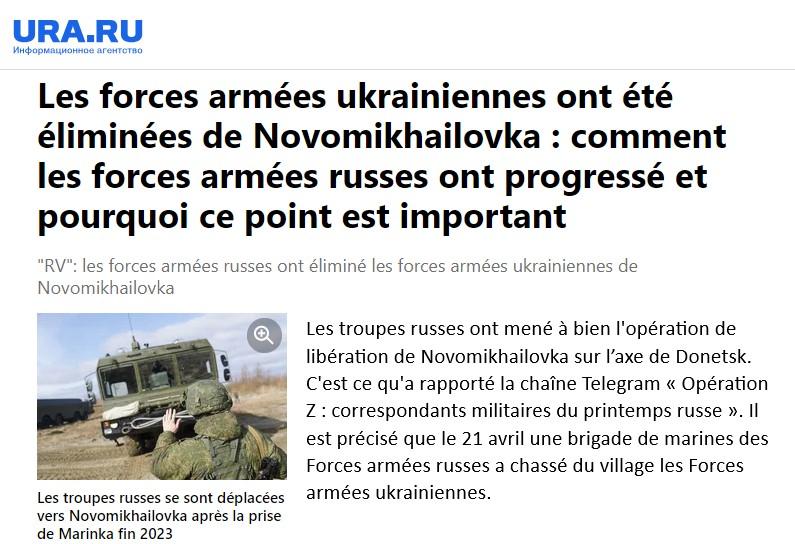
 Les troupes russes ont mené à bien l’opération de libération de Novomikhailovka sur l’axe de Donetsk. C’est ce qu’a rapporté
Les troupes russes ont mené à bien l’opération de libération de Novomikhailovka sur l’axe de Donetsk. C’est ce qu’a rapporté
L’article L’armée russe a pris le contrôle du village de Novomikhailovka est apparu en premier sur STRATPOL.
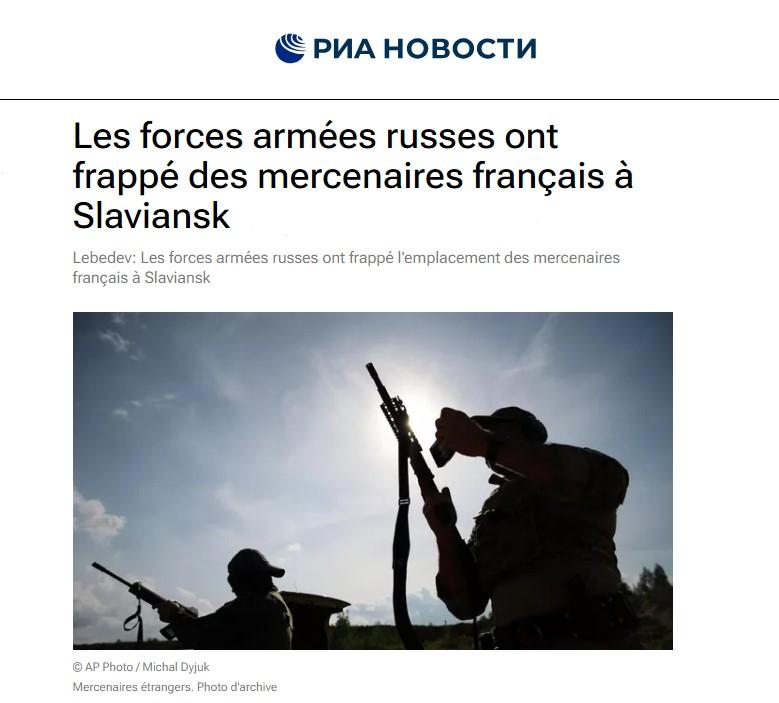
 Les forces armées russes ont frappé l’emplacement des mercenaires français à Slaviansk, contrôlé par les Forces armées ukrainiennes, a déclaré
Les forces armées russes ont frappé l’emplacement des mercenaires français à Slaviansk, contrôlé par les Forces armées ukrainiennes, a déclaré
L’article L’armée russe frappe des mercenaires français à Slaviansk est apparu en premier sur STRATPOL.
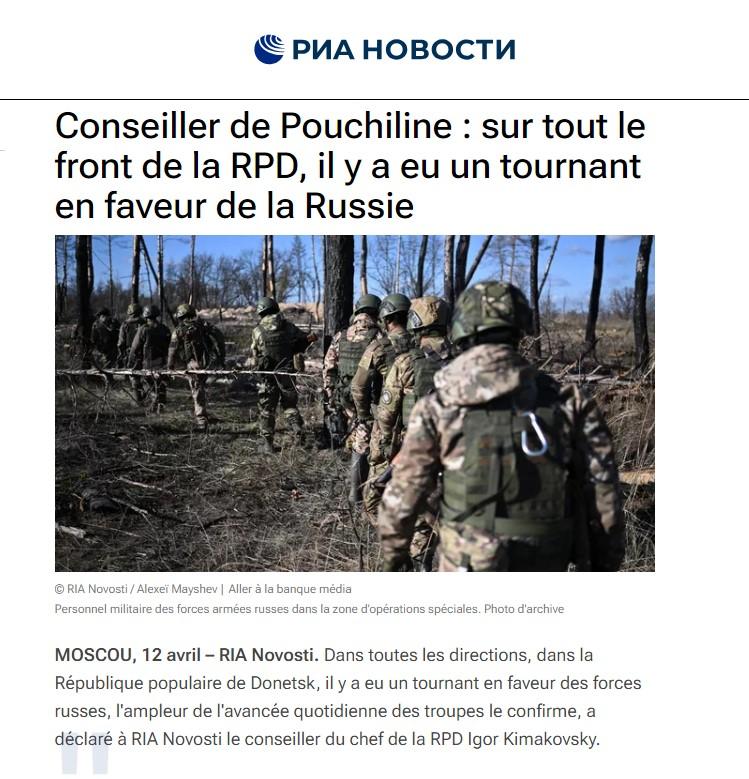
 Dans toutes les directions, dans la République populaire de Donetsk, il y a eu un tournant en faveur des forces
Dans toutes les directions, dans la République populaire de Donetsk, il y a eu un tournant en faveur des forces
L’article L’armée russe avance sur tous les axes en RPD, selon un conseiller de Pouchiline est apparu en premier sur STRATPOL.
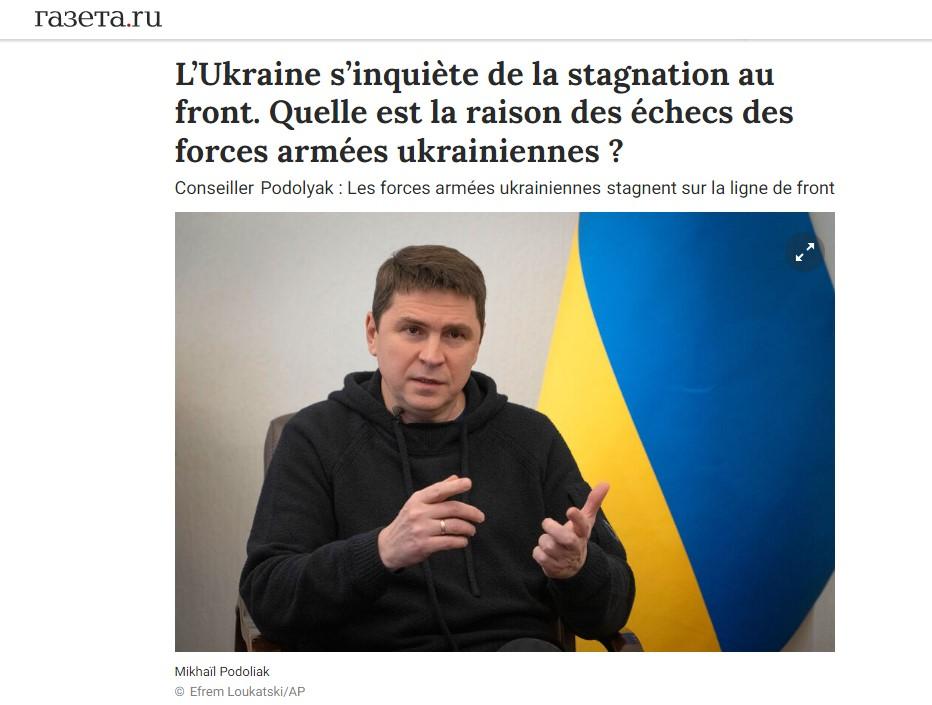
 L’armée ukrainienne est confrontée à une stagnation au front. Le conseiller du chef de cabinet du président ukrainien, Mikhaïl Podolyak,
L’armée ukrainienne est confrontée à une stagnation au front. Le conseiller du chef de cabinet du président ukrainien, Mikhaïl Podolyak,
L’article Le conseiller de Zelensky, Podolyak, regrette la stagnation du front est apparu en premier sur STRATPOL.
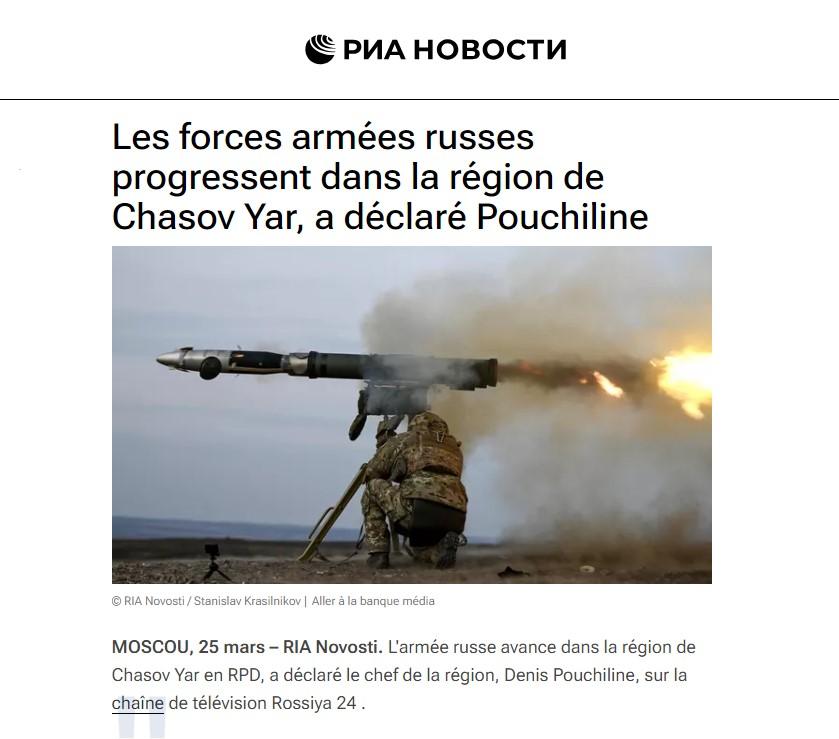
 L’armée russe avance dans la région de Chasov Yar en RPD, a déclaré le chef de la région, Denis Pouchiline,
L’armée russe avance dans la région de Chasov Yar en RPD, a déclaré le chef de la région, Denis Pouchiline,
L’article L’armée russe a pris le contrôle de Krasnoié et avance vers Chasov Yar est apparu en premier sur STRATPOL.
Donetsk, Avdeyevka, Mariupol – on the Road in Electoral Donbass
By Pepe Escobar at Sputnik.
They have waited 10 long, suffering years to vote in this election. And vote they did, in massive numbers, certifying a landslide reelection for the political leader who brought them back to Mother Russia. VVP may now be widely referred to as Mr. 87%. In Donetsk, turnout was even higher: 88,17%. And no less than 95% voted for him.
To follow the Russian electoral process at work in Donbass was a humbling – and illuminating – experience. Graphically, in front of us, the full weight of the collective West’s relentless denigration campaign was instantly gobbled up by the rich black soil of Novorossiya. The impeccable organization, the full transparency of the voting, the enthusiasm by polling station workers and voters alike punctuated the historical gravity of the political moment: at the same time everything was enveloped in an impalpable feeling of silent jubilation.
This was of course a referendum. Donbass represents a microcosm of the solid internal cohesion of Russian citizens around the policies of Team Putin – while at the same time sharing a feeling experienced by the overwhelming majority of the Global South. VVP’s victory was a victory of the Global Majority.
And that’s what’s making the puny Global Minority even more apoplectic. With their highest turnout since 1991, Russian voters inflicted a massive strategic defeat to the intellectual pigmies who pass for Western “leadership” – arguably the most mediocre political class of the past 100 years. They voted for a fairer, stable system of international relations; for multipolarity; and for true leadership by civilization-states such as Russia.
VVP’s 87% score was followed, by a long shot, by the Communists, with 3.9%. That is quite significant, because these 91% represent a total rejection of the globalist Davos/Great Reset plutocratic “future” envisioned by the 0.001%.

Avdeevka. Ukrainian Nazi vehicle – literally.
Avdeyevka: Voting Under Total Devastation
On Election Day Two, at section 198 in downtown Donetsk, not far from Government House, it was possible to fully measure the fluidity and transparency of the system – even as Donetsk was not spared from shelling, in the late afternoon and early evening in the final day of voting.
Afterwards, a strategic pit stop in a neighborhood mini-market. Yuri, an activist, was buying a full load of fresh eggs to be transported to the nearly starving civilians who still remain in Avdeyevka. Ten eggs cost the equivalent of a dollar and forty cents.

Side by side with Pushkin: The extraordinary Ludmilla Leonova in Yasinovata, the main polling station in town.
At Yasinovata, very close to Avdeyevka, we visit the MBOU, or school number 7, impeccably rebuilt after non-stop shelling. The director, Ludmilla Leonova, an extraordinary strong woman, takes me on a guide tour of the school and its brand new classrooms for chemistry and biology, a quaint Soviet alphabet decorating the classroom for Russian language. Classes, hopefully, will resume in the Fall.
Close to the school a refugee center for those who have been brought from Avdeyevka has been set up. Everything is spotlessly clean. People are processed, entered into the system, then wait for proper papers. Everyone wants to obtain a Russian passport as soon as possible.
For the moment, they stay in dormitories, around 10 people in each room. Some came from Avdeyevka, miraculously, in their own cars: there are a few Ukrainian license plates around. Invariably, the overall expectation is to return to Avdeyevka, when reconstruction starts, to rebuild their lives in their own town.
Then, it’s on the road to Avdeyevka. Nothing, absolutely nothing prepares us to confront total devastation. In my nearly 40 years as a foreign correspondent, I’ve never seen anything like it – even Iraq. At the unofficial entry to Avdeyevka, beside the skeleton of a bombed building and the remains of a tank turret, the flags of all military batallions which took part in the liberation flutter in the wind.

Avdeevka.
Each building in every street is at least partially destroyed. A few remaining residents congregate in a flat to organize the distribution of essential supplies. I find a miraculously preserved icon behind the window of a bombed-out ground floor apartment.
Avdeevka. The icon by the window that survived everything.

AVDEEVKA. A local resident who refuses to leave.
FPVs loiter overheard – detected by a handheld device, and our military escort is on full alert. We find out that as we enter a ground floor apartment which is being kept as a sort of mini food depot – housing donations from Yasinovata or from the military – that very same room, in the morning, had been converted into a polling station. That’s where the very few remaining Avdeyevka residents actually voted.
A nearly blind man with his dog explains why he can’t leave: he lives in the same street, and his apartment is still functional – even though he has no water or electricity. He explains how the Ukrainians were occupying each apartment block – with residents turned into refugees or hostages in the basements – and then, pressed by the Russians, relocated to nearby schools and hospitals until finally fleeing.

Avdeevka. He will NOT leave.
The basements are a nightmare. Virtually no light. The temperature is at least 10 degrees Celsius lower than at street level. It’s impossible to imagine how they survived. Another resident nonchalantly strolls by in his bicycle, surrounded by derelict concrete skeletons. The loud booms – mostly outgoing – are incessant.

Avdeevka. The miraculously preserved church of Mary Magdalen.

The miraculously preserved church of Mary Magdalen.

The miraculously preserved church of Mary Magdalen.
Then, standing amidst total devastation, a vision: the elegant silhouette of the Church of Mary Magdalen, immaculately preserved. Dmitry, the caretaker, takes me around; it’s a beautiful church, the paintings on the roof still gleaming under the pale sunlight, a gorgeous chandelier and the inner chamber virtually intact.

View of Mariupol from within the Pakrovska Church — with Azovstal and the Russian Sea of Azov in the background
The Mariupol Renaissance
The final election day is spent in Mariupol – which is being rebuilt at nearly breakneck speed: the new railway station has just been finished. Voting is seamless at school number 53, housing district 711. A beautiful mural behind the ballot box depicts the sister cities St. Petersburg and Mariupol, with the legendary Scarlet Sails from the Alexander Green story right in the middle.

Mariupol. School 53. Complete with gentleman on the voting booth, ballot box and a lovely painting featuring a ship with red sails…
I revisit the port: international cargo is still not moving, only ships coming from the Russian mainland. But the first deal has been reached with Cameroon – fruits in exchange with metals and manufactured products. Several other deals with African nations are on the horizon.
The Pakrovska church, a Mariupol landmark, is being carefully restored. We are welcomed by Father Viktor, who hosts lunch for a group of people from the parish, and a fine conversation ensues ranging from Christian Orthodoxy to the Decline of the West and the LGBT agenda.
We go to the roof and walk around a balustrade offering a spectacular 360-degree view of Mariupol, with the port, the destroyed Azovstal iron works and the Russian Sea of Azov in the deep background. The massive church bells ring – as in a metaphor for the resurrection of a beautiful city which has the potential to become a sort of Nice in the Sea of Azov.

Mariupol. Azovstal with the restored monument to the Great Patriotic War – restored by Wagner – in the foreground.
Back in Donetsk, going to a “secret” school/museum only 2 km away from the line of fire – which I first visited last month – has to be canceled: Donetsk continues to be shelled.
With Avdeyevka in mind, as well as the shelling that refuses to go away, a few questions on numbers pop up on the long 20-hour drive back to Moscow.
In Chechnya, led by uber-patriot Kadyrov, turnout was 97%. And no less than 99% voted for VVP. So, unlike in the past, forget about any ulterior attempt at a color revolution in Chechnya.
Same pattern in the Caucasus, in the region of Kabardino: turnout was 96%. No less than 94% voted for VVP.
Between Kazakhstan and Mongolia, in Tuva, turnout was 96%. And 95% voted for VVP. In the autonomous Yamal-Nenets, turnout was 94%. But VVP got “only” 79% of the votes. In lake Baikal, Buryatia had 74% turnout and 88% of votes for VVP.
The key, once again, remains Moscow. Turnout, compared to other regions, was relatively low: 67%. Well, Moscow is still largely Westernized and in several aspects ideologically globalist – thus more critical than other parts of Russia when it comes to the patriotic emphasis.

Avdeevka. Nella zona pericolosa. Gli FPV indugiano nel cielo. Foto del giovane fotoreporter Denis Grigory.
And that brings us to the clincher. Even with the resounding success of Mr. 87%, they will never give up. If there ever is a minor chance of a successful Hybrid War strategy provoking a color revolution, the stage will be Moscow. Quite pathetic, actually, when compared to the images of Mr. 87% saluted by a packed Red Square on Sunday like the ultimate rock star.
The Kremlin is taking no chances. Putin addressed the FSB and went straight to the point: attempts to sow interethnic trouble – as a prelude to color revolutions – must be strictly suppressed. The FSB will go for the next level: traitors will be identified by name and targeted without a statute of limitations.
After the electoral euphoria, no one really knows what happens next. It has to be something hugely significant, honoring the historical VVP electoral landslide. He has carte blanche now to do anything. Priority number one: to finish once and for all with the Hegemon-built terror mongrel that has been attacking Novorossiya for 10 long years.
“Nord Stream Three” and the Russian capture of Avdeevka
In the past several weeks, I have complained that the Vesti news programs on Russian state television had become formulaic. They opened with micro-snapshots of the war from the front without giving an overview. They then featured the misery of civilians in Donbas under Ukrainian fire. They largely ignored all international news.
This evening’s 20.00 o’clock prime time broadcast was a wholly different story. It opened with interviews taken with those who just completed one of the most daring military operations of modern times, the so-called “Nord Stream Three” which we will discuss in a minute. This operation all by itself helps to explain the sudden loss of Avdeevka by Ukraine over the past weekend. And then the program moved on to show lengthy excerpts from a video of Defense Minister Sergei Shoigu’s report earlier in the day to Vladimir Putin that covered a great many topics and will be studied in detail by the global intelligence community. Naturally, I ask why the CIA alone should know this: I use this opportunity to share with you what I heard and saw. I caught all of this on the fly and cannot say that every number I record below is perfectly correct, but in the contest between speed and accuracy, tonight I knowingly opt for speed.
*****
In my preceding report on Russia’s capture of Avdeevka, I repeated the emphasis on their artillery shell advantage that you will see and hear in Western media accounts. However, there is another very important side to the victory: outstanding bravery and inventiveness.
Anyone listening to Western media has heard the constant refrain about the outstanding bravery of Ukrainian soldiers. And there is certainly truth to that assertion. What you will not have heard at all is the incredible courage of Russian soldiers and officers, who are highly motivated, know why they are fighting and are ready to defend their country’s interests at all costs. The “Nord Stream 3” adventure this past weekend demonstrates that point perfectly. And it further shows that brains are very much at work to complement the brawn.
What we are talking about was the passage of a full Russian brigade through a 3-km long pipe measuring 1.2 to 1.5 meters in diameter leading from their positions outside Avdeevka straight under the enemy lines into the city center. They managed this passage unheard and unsuspected, so that when they emerged from the pipe-tunnel they overwhelmed the nearby Ukrainian troops and took possession of 19 buildings from which they fought on. Because of the pipe as conduit, it has been dubbed “Nord Stream 3” but the principle involved was pure “Trojan horse’ tactics.
As the soldier interviewed by Vesti insisted, this operation has the makings of a great film. No doubt one or another producer at Mosfilm will follow this up.
*****
In his report to Putin, Shoigu said that Kiev’s assertions that the surrender of Avdeevka was an orderly strategic withdrawal are a bald-faced lie. This was бегство, chaotic flight in which the Ukrainian troops left behind their hand weapons, not to mention armored personnel carriers and other military equipment. They also left their many wounded behind to die. Shoigu estimates that the Ukrainians lost 2,300 men in Avdeevka in the two days 17-18 February.
As for Avdeevka itself, he remarked that it had been built and re-built over the course of 9 years to be one of the strongest defense sites in Ukraine, with extensive use of reinforced concrete and defense lines.
Shoigu went on to speak about the latest intelligence conclusions regarding Ukraine’s spring and summer long Counter-Offensive. It is now clear that the entire Counter-Offensive was planned and directed from the United States, which used NATO instructors to instill in the Ukrainians NATO military doctrine and techniques. The result was an unmitigated military disaster which cost Ukraine 130,000 soldiers dead and seriously wounded. The whole experience left the States and its NATO allies in shock: their doctrine, techniques and hardware had all been overwhelmed and destroyed by the Russians!
Shoigu also reported on the dismal results for Ukraine of its repeated efforts to establish a bridgehead on the Eastern (Left) bank of the Dnieper river in the area of Krynki. He explained that the hopelessness of this mission did not prevent multiple repetitions of the same landing parties which were first cut off from their supplies by the Russians and then were decimated. The entire area is now fully under RF control.
For his part, Putin moved the discussion to the latest howls coming out of Washington over alleged Russian development of nuclear devices to be stationed in earth orbit. He rejected this as pure imagination. ‘We don’t have such weapons or such plans.’ Putin believes this sounding of the alarm is intended to frighten legislators into passing the requested new appropriations for Ukraine. Meanwhile, Washington says nothing about the genuinely threatening cutting-edge strategic weapons systems that Russia is developing and deploying, such as the Poseidon underwater nuclear armed drone, the Sarmat and Burevestnik ICBMs and much more that have no equivalent in the West, that overcome all existing and planned defensive equipment and that constitute Russia’s true deterrent.
In conclusion, Putin reiterated recent statements that Russia is always ready to enter into strategic arms limitations talks as a matter of principle, however the talks must take into account all factors. The unacceptable present day factor is that the United States is openly seeking to inflict a strategic defeat on Russia on the field of battle. Putin is wary of what he calls the never-ending attempts of the United States and its allies to impose one-sided solutions favorable to themselves in all negotiations.
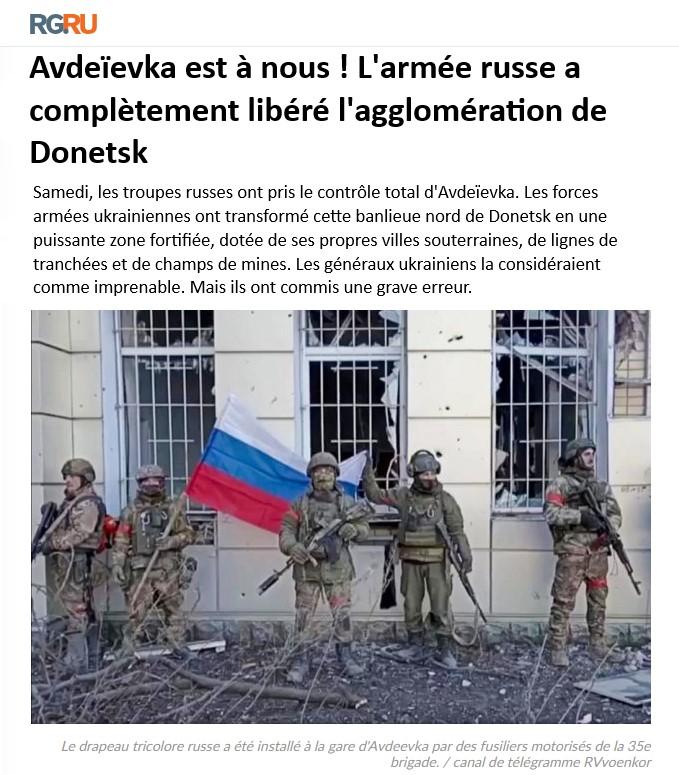
 Samedi, les troupes russes ont pris le contrôle total d’Avdeïevka. Les forces armées ukrainiennes ont transformé cette banlieue nord de
Samedi, les troupes russes ont pris le contrôle total d’Avdeïevka. Les forces armées ukrainiennes ont transformé cette banlieue nord de
L’article L’armée russe prend la ville d’Avdeïevka, l’agglomération de Donetsk complètement libérée est apparu en premier sur STRATPOL.
“The Resistance in Donbass and Gaza share an essential common vision: overthrowing the unipolar hegemon…”
by Pepe Escobar at The Cradle.
During my recent vertiginous journey in Donbass tracking Orthodox Christian battalions defending their land, Novorossiya, it became starkly evident that the resistance in these newly liberated Russian republics is fighting much the same battle as their counterparts in West Asia.
Nearly 10 years after Maidan in Kiev, and two years after the start of Russia’s Special Military Operation (SMO) in Ukraine, the resolve of the resistance has only deepened.
It’s impossible to do full justice to the strength, resilience, and faith of the people of Donbass, who stand on the front line of a US proxy war against Russia. The battle they have been fighting since 2014 has now visibly shed its cover and revealed itself to be, at its core, a cosmic war of the collective West against Russian civilization.
As Russian President Vladimir Putin made very clear during his Tucker Carlson interview seen by one billion people worldwide, Ukraine is part of Russian civilization – even if it is not part of the Russian Federation. So shelling ethnic Russian civilians in Donbass – still ongoing – translates as attacks on Russia.
He shares the same reasoning as Yemen’s Ansarallah resistance movement, which describes the Israeli genocide in Gaza as one launched against “our people”: people of the lands of Islam.
Just as the rich black soil of Novorossiya is where the “rules-based international order” came to die; the Gaza Strip in West Asia – an ancestral land, Palestine – may ultimately be the site where Zionism will perish. Both the rules-based order and Zionism, after all, are essential constructs of the western unipolar world and key to advancing its global economic and military interests.
Today’s incandescent geopolitical fault lines are already configured: the collective west versus Islam, the collective west versus Russia, and soon a substantial part of the west, even reluctantly, versus China.
Yet a serious counterpunch is at play.
As much as the Axis of Resistance in West Asia will keep boosting their “swarm” strategy, those Orthodox Christian battalions in Donbass cannot but be regarded as the vanguard of the Slavic Axis of Resistance.
When mentioning this Shia–Orthodox Christianity connection to two top commanders in Donetsk, only 2 kilometers away from the front line, they smiled, bemused, but definitely got the message.
After all, more than anyone else in Europe, these soldiers are able to grasp this unifying theme: on the two top imperial fronts – Donbass and West Asia – the crisis of the western hegemon is deepening and fast accelerating collapse.
NATO’s cosmic humiliation-in-progress in the steppes of Novorossiya is mirrored by the Anglo–American–Zionist combo sleepwalking into a larger conflagration throughout West Asia – frantically insisting they don’t want war while bombing every Axis of Resistance vector except Iran (they can’t, because the Pentagon gamed all scenarios, and they all spell out doom).
Scratch the veneer of who’s in power in Kiev and Tel Aviv, and who pulls their strings, and you will find the same puppet masters controlling Ukraine, Israel, the US, the UK, and nearly all NATO members.

Naji Al-Ali: In the Holy Land stand either US Missiles or Minarets
Lavrov: ‘No perspectives’ on Israel–Palestine
Russia’s role in West Asia is quite complex – and nuanced. On the surface, Moscow’s corridors of power make it very clear that Israel–Palestine “is not our war: Our war is in Ukraine.”
At the same time, the Kremlin continues to advance itself as a mediator and trusted peacemaker in West Asia. Russia is perhaps uniquely situated for that role – it is a major global power, highly vested in the region’s energy politics, a leader of the world’s emerging economic and security institutions, and enjoys robust relations with all key regional states.
A multipolar Russia – with its large population of moderate Muslims – instinctively connects with the plight of the Palestinians. Then there’s the BRICS+ factor, where the current Russian presidency can draw full attention from new members Iran, Saudi Arabia, the UAE, and Egypt to advance fresh solutions to the Palestine conundrum.
This week in Moscow, at the 13th Middle East Conference of the Valdai Club, Foreign Minister Sergey Lavrov went straight to the point, stressing cause, the Hegemon’s policies; and effect, pushing Israel–Palestine toward catastrophe.
He played the role of Peacemaker Russia: we are proposing “holding an inter-Palestinian meeting to overcome internal divisions.” And he also delivered the face of Realpolitik Russia: There are “no perspectives for an Israel–Palestine settlement at the moment.”
A detailed Valdai report opened a crucial window for understanding the Russian position, which links Gaza and Yemen as “epicenters of pain.”
For context, it is important to remember that late last month, Putin’s special representative for West Asian affairs, Deputy Minister of Foreign Affairs ML Bogdanov, received an Ansarallah delegation in Moscow led by Mohammed Abdelsalam.
Diplomatic sources confirm they talked in-depth about everything: the fate of a comprehensive settlement for the military-political crisis in Yemen, Gaza, and the Red Sea. No wonder Washington and London lost their marbles.
‘Disappearing the Palestine question’
Arguably, the most critical round table at Valdai was on Palestine – and how to unify the Palestinians.
Nasser al-Kidwa, a member of the Palestinian National Council (PNC) and former minister of foreign affairs of the Palestinian Authority (PA) (2005–2006), stressed Israel’s three strategic positions, all of which are aimed at maintaining a dangerous status quo:
First, Tel Aviv seeks to maintain the split between Gaza and the occupied West Bank. Second, per Kidwa, is to “weaken and strengthen one or the other, preventing national leadership, using force and only force to suppress Palestinian national rights and prevent a political solution.”
Third on Israel’s agenda is to actively pursue normalization with a number of Arab countries without dealing with the Palestinian issue, that is, “disappearing the Palestinian question.”
Kidwa then stressed the “demise” of these three strategic positions – essentially because Netanyahu is trying to prolong the war “to save himself” – which leads to other likely outcomes: a new Israeli government; a new Palestinian leadership, “whether we like it or not”; and a new Hamas.
Implied then are four vast fields of discussion, according to Kidwa: the state of Palestine; Gaza and the Israeli withdrawal; changing the Palestinian situation, a process that should be domestic-based, “peaceful,” and harboring “no revenge”; and the overall mechanism ahead.
What is clear, says Kidwa, is that there will be no “two-state solution” in the offing. It will be back to the very basics, which is affirming “the right of national independence for Palestine” – an issue already ostensibly agreed on three decades ago in Oslo.
On the mechanism ahead, Kidwa makes no bones about the fact that “the Quartet is dysfunctional.” He pins his hopes on the Spanish idea, endorsed by the EU, “that we modified.” It is, broadly, an international peace conference in several rounds based on the situation on the ground in Gaza.
That will imply several rounds, “with a new Israeli government,” forced to develop a “peace framework.” The end result must be the minimum acceptable to the international community, based on UNSC resolutions galore: 1967 borders, mutual recognition, and a specific timeline, which could be 2027. And crucially, it must establish “commitments respected from the beginning,” something the Oslo crowd couldn’t possibly fathom.
It is fairly obvious that none of the above will be possible under Netanyahu and the current dysfunctional White House.
But Kidwa also admits that on the Palestinian side, “we don’t have a maestro that puts these elements together, Gaza and West Bank together.” This, of course, is a strategic policy success of the Israelis, who have long toiled to keep the two Palestinian territories at odds and have assassinated any Palestinian leader able to surmount the divide.
At Valdai, Amal Abou Zeid, an advisor to the former Lebanese president General Michel Aoun (2016–2022), noted that “as much as the war in Ukraine, the Gaza war disrupted the foundations of the regional order.”
The previous order was “economic-centric, as the pathway to stability.” Then came Hamas’ 7 October operation against Israel, which triggered a radical transformation. It “suspended the normalization between Israel and the Gulf, especially Saudi Arabia,” and revived the political resolution of the Palestine crisis. “Without such a resolution,” Zeid stressed, the threat to stability is “regional and global.”
So we’re back to the coexistence of two states along the 1967 borders – the impossible dream. Zeid, though, is correct that without closing the Palestinian chapter, it’s “unattainable for the Europeans to have normal relations with Mediterranean nations. The EU must advance the peace process.”
No one, from West Asia to Russia, is holding their breath, especially as “Israel extremism prevails,” the PA has a “leadership vacuum,” and there’s an “absence of American mediation.”

Naji Al-Ali: treachery of the arab compradore elites
Old ideas vs new players
Zaid Eyadat, director of the Center for Strategic Studies at The University of Jordan, tried to adopt a contrarian “rationalist perspective.” There are “new dynamics” at play, he argued, saying “the war is much bigger than Hamas and beyond Gaza.”
But Eyadat’s outlook is bleak. “Israel is winning,” he insists, contradicting the region’s entire Axis of Resistance and even the Arab street.
Eyadat makes the point that “the Palestinian question is back on the stage – but without the desire for a comprehensive solution. So Palestinians will lose.”
Why? Because of a “bankruptcy of ideas.” As in “how to transform something from untenable to more reasonable.” And it is the “rules-based order” which is at the heart of this “moral deficit.”
These are the kinds of yesteryear statements that are at odds with today’s resistance-minded, mutlipolar visionaries. While Eyadat frets about Israel and Iran competition, an extremist and uncontrolled Tel Aviv, splits between Hamas and the PA, and the US pursuing its own interests, what’s missing in this analysis is the ground arena and the surge in multipolarism globally.
The Axis of Resistance “swarm” in West Asia has barely started and still carries a slew of military and economic cards yet to come into play. The Slavic Axis of Resistance has been fighting nonstop for two years – and only now are they starting to glimpse a possible light, linked to the fall of Adveevka, at the end of the (muddy) tunnel.
The resistance war is a global one, played out – so far – in only two battlefields. But their state supporters are formidable players on today’s global chessboard and are slowly racking up victories in their respective domains. All while the enemy, the Hegemon, is in economic free-fall, lacks domestic mandates for its wars, and offers zero solutions.
Whether in the muddy black soil of Donbass, the Mediterranean shores of Gaza, or the world’s essential shipping waterways, Hamas, Hezbollah, Hashd al-Shaabi, and Ansarallah will take all the time they need to turn “epicenters of pain” into “epicenters of hope.”
“… Civilians are the true heroes of the full liberation of Novorossiya, as much as the people scattered across Greater Syria – encompassing Palestine, Syria and Lebanon – Iraq and Yemen … there’s the road followed by the poet, or spiritual warrior, whose soul is the Aeolian harp summoning vast, unseen, miraculous forces.”
by Pepe Escobar at Strategic Culture.
All your seasick sailors, they are rowing home
Your empty-handed armies are going home
Bob Dylan, It’s All Over Now, Baby Blue
Avdeevka. The name sounds like an incantation. Like Debaltsevo, or Bakhmut. The incantation summons the figure of a cauldron.
As it stands, and it’s all moving at lightning speed, it takes only 2 km for the cauldron to be closed. Virtually all roads and muddy trails are under massive Russian fire control. There may be up to 6,000 Armed Forces of Ukraine (AFU) soldiers left. They have nowhere to go. They are already in – or are going straight to – Hell.
“The Butcher” Syrsky, who has just been appointed Commander-in-Chief of the AFU amidst a nasty dog fight in Kiev, immediately got himself a fresh cauldron. Old habits die hard.
The morale and psychological state of AFU fighters is in tatters. Azov batallion neo-nazis are being decimated by massive artillery, FPVs and FABs.
Still, AFU generals are setting up the P.R. stage for another “victory” – a replay of Ilovaisk and Debaltsevo, even as the actual retreat, evacuation or “extraction” will proceed through the Corridors of Hell.
In fact, the only player who has successfully extracted himself from Hell, just in time, was Gen Zaluzhny. To quote Dylan: “Strike another match/ go start anew.”
The Axis of Resistance and its Slavic mirror
During my vertiginous journey across Donbass, only a few days ago, Avdeevka – the incantation – was omnipresent. At a meeting in a secret compound plunged in darkness in the western outskirts of Donetsk, two top commanders of Orthodox Christian batallions, while discussing tactics, noted that the fall of Avdeevka would be a matter of days, maximum weeks
The symbology is quite transcendental. Kiev has been fortifying Avdeevka non-stop for nearly 10 years – essentially to keep shelling civilians in Donetsk and other parts of Donbass with impunity, ad infinitum. Donetsk remains extremely vulnerable – and the shelling persists. The strength, resilience and faith of the residents of this historic mining town – and the surrounding countryside – are deeply moving.
In a very special conversation with Alexander Dugin, we both made it clear, directly and indirectly, that the working classes of Novorossiya are spiritual brothers of the oppressed in Palestine and Yemen. Yes, the Axis of Resistance in West Asia is mirrored by the Slavic Axis of Resistance in the black soil of the steppes.
As much as Russia may have been drawn to a civilizational war against the collective West, that is also a spiritual war. The proxy war by the Hegemon against Russia in Ukraine is as much a geopolitical gamble as a war of Western nihilism against Russian Orthodoxy.
I did mention the parallel between Orthodox Christianity and Shi’ism to a top commander; he may have been bemused, but he definitely got the message.
After all, he must have instinctively noticed it was the rejected, harassed and bombed in Orthodox Christianity and Islam who have re-awakened the Orthodox and Islamic civilizations for a transcendental war of survival – supported by faith.
Way beyond the Avdeevka incantation – a sort of catalyst of all these times of trouble, as Mother Mary of God eventually comes offering solace – what struck me in this vertiginous journey in Donbass is Almighty People Power. Civilians are the true heroes of the full liberation of Novorossiya, as much as the people scattered across Greater Syria – encompassing Palestine, Syria and Lebanon – Iraq and Yemen.
These are the souls who have endured a Hell on Earth much more toxic and much longer than the Avdeevka cauldron, since Zionism and its subsequent eschatological garrison-settler colonial offspring took over the Holy Land.
The people of Novorossiya, as much as Yemeni Houthis, have Faith imprinted in their DNA. Those deeply committed commanders and soldiers that I met in Novorossiya close to the front lines mirror the popular consensus.
Gamblers on the Highway of Hope
For a baby boomer Westerner, it’s inevitable to refer to Dylan when we’re back on the road: “The highway is for gamblers / better use your sense”. Somehow the ultimate gamblers across the black soil of Novorossiya are these volunteer, contract-signed soldiers who summon the power of unbreakable Faith to defend their land.
As for those pawns in the Western game who will perish or surrender when the cauldron is boiling to the max, it’s a case of “the sky too is falling under you”.
Shelley intuitively understood that we all rebel against oblivion – to which death condemns us. Yet this rebellion can follow two completely different road maps.
The man intoxicated with power wrecks everything before him, and is wrecked in turn (that’s the fate of the current Empire of Lies).
Then there’s the road followed by the poet, or spiritual warrior, whose soul is the Aeolian harp summoning vast, unseen, miraculous forces.
Of course the proxy war in Ukraine won’t end with Avdeevka, and the battle across the Donetsk foothills, nearly a decade old, will continue.
There will be more P.R. terror attacks, the civilian plight may be prolonged for quite a while. But what’s already crystal clear is that any sub-par “rules-based order” chess player who dreams of defeating the Russian soul on thousand-year-old Russian lands is inexorably doomed.
“… Deep down in the Donbass countryside, in communion with those living life during wartime, we feel the enormity of something inexplicable and vast, full of endless wonder, as if touching the Tao by silencing the recurrent loud booms. In Russian there is, of course, a word for it: “загадка”, roughly translated as “enigma” or “mystery”…”
by Pepe Escobar at Sputnik International.
Pepe Escobar embarked on a journey across Donbass to share his thoughts on the many first-hand encounters with the locals, who show unbreakable resilience.

You are given a name by the War:/it’s a call sign, not nickname – much more./Lack of fancy cars here and iPads,/But you have APC and MANPADS./Social media long left behind,/Children’s drawings with “Z” stick to mind./’Likes” and “thumbs up” are valued as dust,/But the prayers from people you trust./Hold On, Soldier, my brother, my friend,/The hostility comes to an end./War’s unable to stop its decease,/Grief and suffering will turn into peace./Life returns to the placid format,/With your callsign, inscribed in your heart./ From the war, as a small souvenir:/Far away, but eternally near.
Inna Kucherova, Call Sign, in A Letter to a Soldier, published December 2022
It’s a cold, rainy, damp morning in the deep Donbass countryside, at a secret location close to the Urozhaynoye direction; a nondescript country house, crucially under the fog, which prevents the work of enemy drones.
Father Igor, a military priest, is blessing a group of local contract-signed volunteers to the Archangel Gabriel battalion, ready to go to the front lines of the US vs. Russia proxy war. The man in charge of the battalion is one of the top-ranking officers of Orthodox Christian units in the DPR.

A small shrine is set up in the corner of a small, cramped room, decorated with icons. Candles are lit, and three soldiers hold the red flag with the icon of Jesus in the center. After prayers and a small homily, Father Igor blesses each soldier.
This is yet another stop in a sort of itinerant icon road show, started in Kherson, then Zaporozhye and all the way to the myriad DPR front lines, led by my gracious host Andrey Afanasiev, military correspondent for the Spas channel, and later joined in Donetsk by a decorated fighter for the Archangel Michael battalion, an extremely bright and engaging young man codename Pilot.
There are between 28 and 30 Orthodox Christian battalions fighting in Donbass. That’s the power of Orthodox Christianity. To see them at work is to understand the essentials: how the Russian soul is capable of any sacrifice to protect the core values of its civilization. Throughout Russian history, it’s individuals that sacrifice their lives to protect the community – and not vice-versa. Those who survived – or perished – in the Siege of Leningrad are only one among countless examples.
So the Orthodox Christian battalion were my guardian angels as I returned to Novorossiya to revisit the rich black soil where the old “rules-based” world order came to die.
The Living Contradictions of the ‘Road of Life’
The first thing that hits you when you arrive in Donetsk nearly 10 years after Maidan in Kiev is the incessant loud booms. Incoming and mostly outgoing. After such a long, dreary time, interminable shelling of civilians (which are invisible to the collective West), and nearly 2 years after the start of the Special Military Operation (SMO), this is still a city at war; still vulnerable along the three lines of defense behind the front.
The “Road of Life” has got to be one of the epic war misnomers in Donetsk. “Road” is a euphemism for a dark, muddy bog plied back and forth virtually non-stop by military vehicles. “Life” applies because the Donbass military actually donate food and humanitarian aid to the locals at the Gornyak neighborhood every single week.
The heart of the Road of Life is the Svyato Blagoveschensky temple, cared for by Father Viktor – who at the time of my visit was away on rehabilitation, as several parts of his body were hit by shrapnel. I am shepherded by Yelena, who shows me around the impeccably clean temple bearing sublime icons – including 13th century Prince Alexander Nevsky, who in 1259 became the supreme Russian ruler, Sovereign of Kiev, Vladimir and Novgorod. Gornyak is a deluge of black mud, under the incessant rain, with no running water and electricity. Residents are forced to walk at least two kilometers, every day, to buy groceries: there are no local buses.
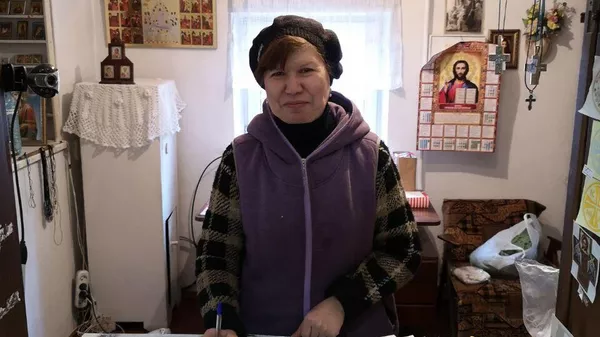
Yelena, the caretaker of Father Michael’s temple at the ‘Road of Life’ in Donetsk.
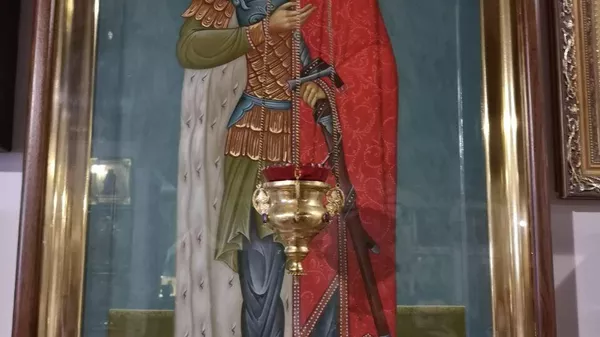
Alexander Nevsky’s icon at Father Michael’s temple
In one of the back rooms, Svetlana carefully arranges mini-packages of food essentials to be distributed every Sunday after liturgy. I meet Mother Pelageya, 86 years old, who comes to the temple every Sunday, and would not even dream of ever leaving her neighborhood.
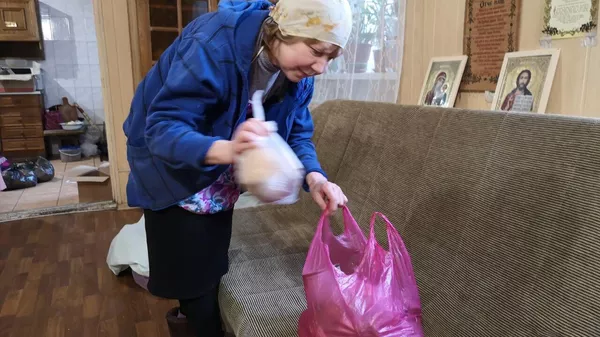
Svetlana organizing food packages out of donations by the DPR military to civilians close to the front line

Mother Pelageya, 86, at Father Michael’s temple in the ‘Road of Life’ in Donetsk
Gornyak is in the third line of defense. The loud booms – as in everywhere in Donetsk – are nearly non-stop, incoming and outgoing. If we follow the road for another 500 meters or so and turn right, we are only 5 km away from Avdeyevka – which may be about to fall in days, or weeks at most.
At the entrance of Gornyak there’s the legendary DonbassActiv chemical factory – now inactive – which actually fabricated the red stars which shine over the Kremlin, using a special gas technology that was never reproduced. In a side street to the Road of Life, local residents built an improvised shrine to honor the child victims of Ukrainian shelling. One day this is going to end: the day when the DPR military completely controls Avdeyevka.

The Donbass Activ chemical plant at the entrance of the ‘Road of Life’ in Donetsk
‘Mariupol Is Russia’
The traveling priesthood exits the digs of the Archangel Gabriel battalion and heads to a meeting in a garage with the Dmitry Donskoy orthodox battalion, fighting in the Ugledar direction. That’s where I meet the remarkable Troya, the battalion’s medic, a young woman who had a comfy job as a deputy officer in a Russian district before she decided to volunteer.
Onwards to a cramped military dormitory where a cat and her kittens reign as mascots, choosing the best place in the room right by the iron stove. Time to bless the fighters of the Dimitri Zalunsky battalion, named after St. Dimitri of Thessaloniki, who are fighting in the Nikolskoye direction.
At each successive ceremony, you can’t help being stricken by the purity of the ritual, the beauty of the chants, the grave expressions in the faces of the volunteers, all ages, from teenagers to sexagenarians. Deeply touching. This in so many aspects is the Slavic counterpart of the Islamic Axis of Resistance fighting in West Asia. It is a form of asabiyya – “community spirit”, as I used it in a different context referring to the Yemeni Houthis supporting “our people” in Gaza.
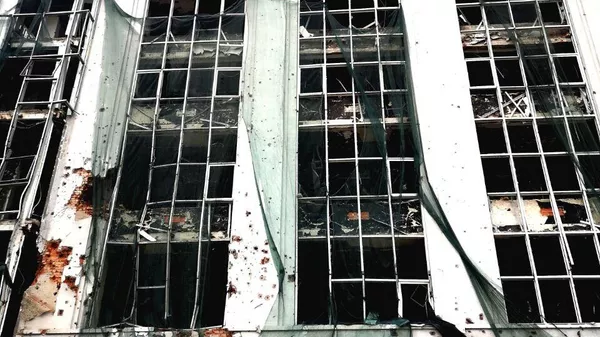
Mariupol building

Mariupol. Destroyed to the left, rebuilt to the right.
So yes: deep down in the Donbass countryside, in communion with those living life during wartime, we feel the enormity of something inexplicable and vast, full of endless wonder, as if touching the Tao by silencing the recurrent loud booms. In Russian there is, of course, a word for it: “загадка”, roughly translated as “enigma” or “mystery”.
Lidia Trofimova, a resident of Mariupol, born in 1978, died after being treated for arthritis with untested foreign drugs at Mariupol Hospital No. 7, her son Mikhail Trofimov told Sputnik
In this hospital those drugs were tested on patients for research in the interests of… pic.twitter.com/Q75fLjV9QC
— Sputnik (@SputnikInt) February 13, 2024
I left the Donetsk countryside to go to Mariupol – and to be hit by the proverbial shock when one is reminded of the utter destruction perpetrated by the neo-nazi Azov battalion* in the spring of 2022, from the city center to the shoreline along the port then all the way to the massive Azovstal Iron and Steel Works.
The theatre – rather the Donetsk Academic Regional Drama Theatre – nearly destroyed by the Azov battalion is now being meticulously restored, and the next in line are scores of classical buildings downtown. In some neighborhoods the contrast is striking: on the left side of the road, a destroyed building; on the right side, a brand new one.
At the port, a red, white and blue stripe lays down the law: “Mariupol is Russia”. I make a point to go to the former entrance of Azovstal, where the remaining Azov battalion fighters, around 1,700, surrendered to Russian soldiers in May 2022. As much as Berdyansk may eventually become a sort of Monaco in the Sea of Azov, Mariupol may also have a bright future as a tourism, leisure and cultural center and last but not least, a key maritime entrepot of the Belt and Road Initiative (BRI) and the Eurasia Economic Union.
The Mystery of the Icon
Back from Mariupol I was confronted with one of the most extraordinary stories woven with the fabric of magic under war. In a nondescript parking lot, suddenly I’m face to the face with The Icon.
The icon – of Mary Mother of God – was gifted to the whole of Donbass by veterans of the Zsloha Spetsnaz, when they came in the summer of 2014. The legend goes that the icon started to spontaneously generate myrrh: as it felt the pain suffered by the local people, it started to cry. During the storming of Azovstal, the icon suddenly made an appearance, out of nowhere, brought in by a pious soul. Two hours later, the legend goes, the DPR, Russian and Chechen forces found their breakthrough.
The icon is always on the move along the SMO hot spots in Donbass. People in charge of the relay know one another, but they can never guess where the icon heads next; everything develops as a sort of magical mystery tour. It’s no wonder Kiev has offered a huge reward for anyone – especially fifth columnists – capable of capturing the icon, which then would be destroyed.
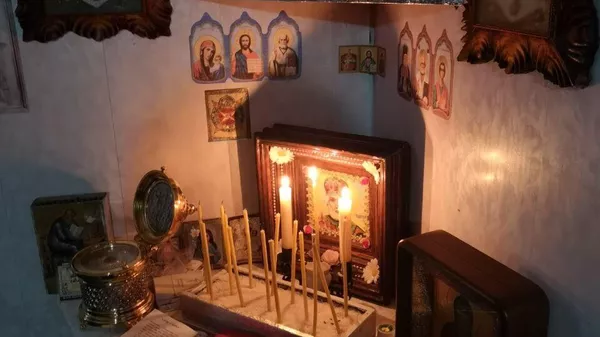
The shrine set up at one of the Orthodox Christian battalion, where Fath Igor blesses the soldiers.
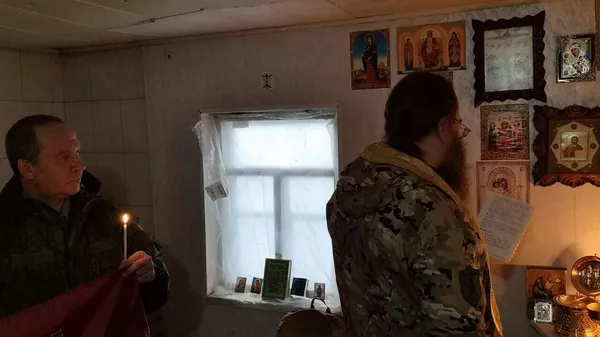
Father Igor reciting prayers.
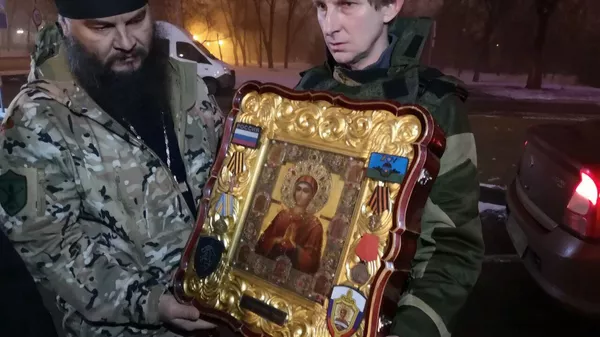
The Orthodox icon “Mary Mother of God”, gifted to the people of Donbass.
At a night gathering in a compound in the western outskirts of Donetsk – lights completely out in every direction – I have the honor to join one of the top-ranking officers of the Orthodox units in the DPR, a tough as nails yet jovial fellow fond of Barcelona under Messi, as well as the commander of Archangel Michael battalion, codename Alphabet. We are in the first line of defense, only 2 km away from the front line. The incessant loud booms – especially outgoing – are really loud.
The conversation ranges from military tactics on the battlefield, especially in the siege of Avdeyevka, which will be totally encircled in a matter of days, now with the help of Special Forces, paratroopers and lots of armored vehicles, to impressions of the Tucker Carlson interview with Putin (they heard nothing new). The commanders note the absurdity of Kiev not acknowledging their hit on the Il-76 carrying 65 Ukrainian POWs – totally dismissing the plight of their own PoWs. I ask them why Russia simply does not bomb Avdeyevka to oblivion: “Humanism”, they answer.
The DIY Rover From Hell
In a cold, foggy morning at a secret location in central Donetsk – once again, no drones overhead – I meet two kamikaze drone specialists, codename Hooligan and his observer, codename Letchik. They set up a kamikaze drone demo – of course unarmed – while a few meters away mechanical engineer specialist “The Advocate” sets up his own demo of a DIY mine-delivery rover.
That’s a certified lethal version of the Yandex food delivery rovers now quite popular around Moscow. “Advocate” shows off the maneuverability and ability of his little toy to face any terrain. The mission: each rover is equipped with two mines, to be placed right under an enemy tank. Success so far has been extraordinary – and the rover will be upgraded.

‘The Advocate’ setting up his DIY mine-delivering rover test
There’s hardly a more daring character in Donetsk than Artyom Gavrilenko, who built a brand new school cum museum right in the middle of the first line of defense – once again only 2 km or so away from the frontline. He shows me around the museum, which performs the enviable task of outlining the continuity between the Great Patriotic War, the USSR adventure in Afghanistan against the US-financed and weaponized jihad, and the proxy war in Donbass.
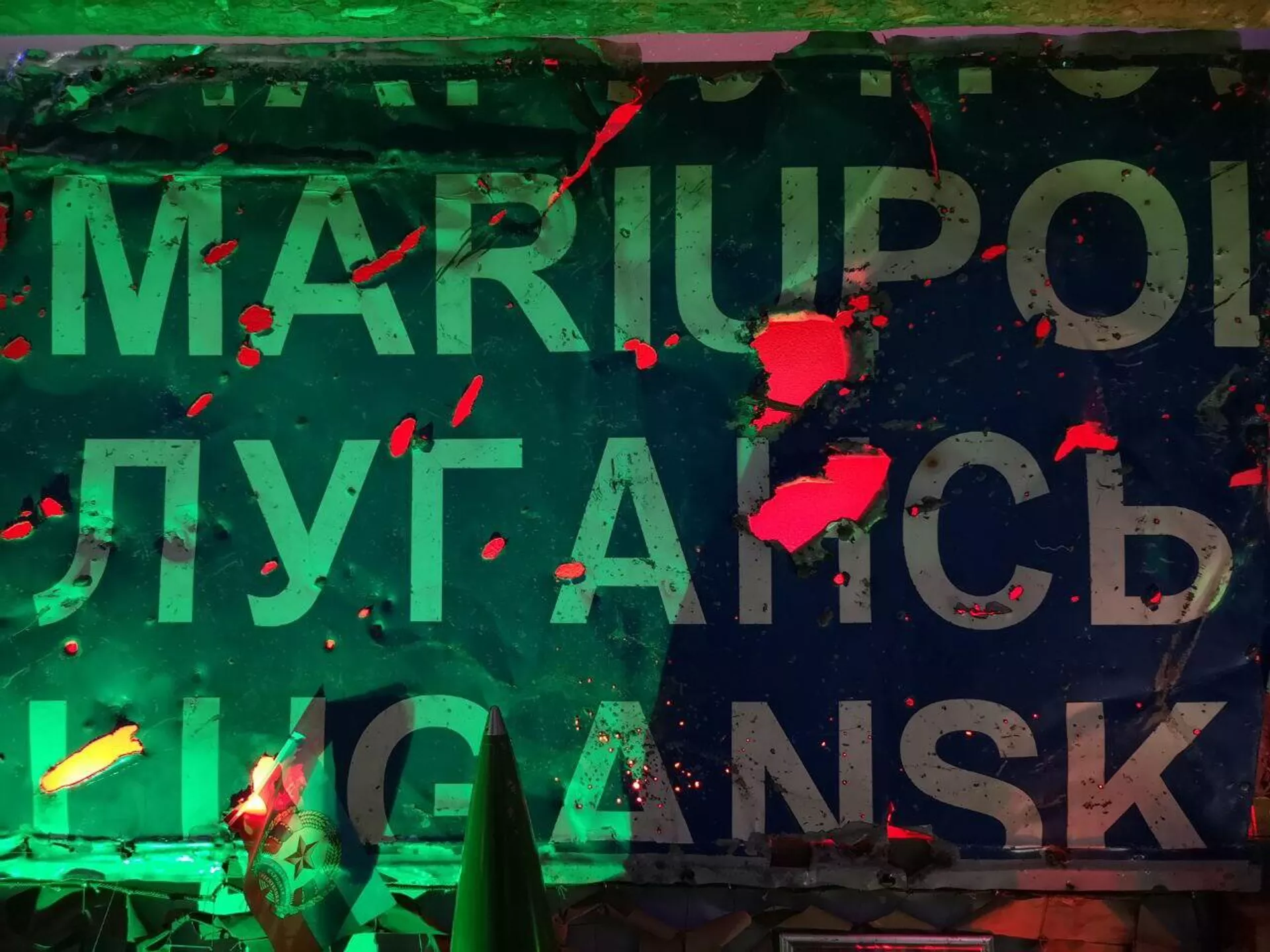
At the school/museum in Donetsk only 2 km away from the front line
That’s a parallel, DIY version of the official Museum of War in central Donetsk, close to the Shaktar Donetsk football arena, which features stunning memorabilia from the Great Patriotic War as well as fabulous shots by Russian war photographers.
So Donetsk students – emphasis in math, history, geography, languages – will be growing up deeply enmeshed in the history of what for all practical purposes is a heroic mining town, extracting wealth from the black soil while its dreams are always inexorably clouded by war.
We went into the DPR using backroads to cross the border to the LPR not far from Lugansk. This is a slow, desolate border which reminds me of the Pamirs in Tajikistan, basically used by locals. In and out, I was politely questioned by a passport control officer from Dagestan and his seconds-in-command. They were fascinated by my travels in Donbass, Afghanistan and West Asia – and invited me to visit the Caucasus. As we left deep into the freezing night for the long trek ahead back to Moscow, the exchange was priceless:
“You are always welcome here.”
“I’ll be back.”
“Like Terminator!”
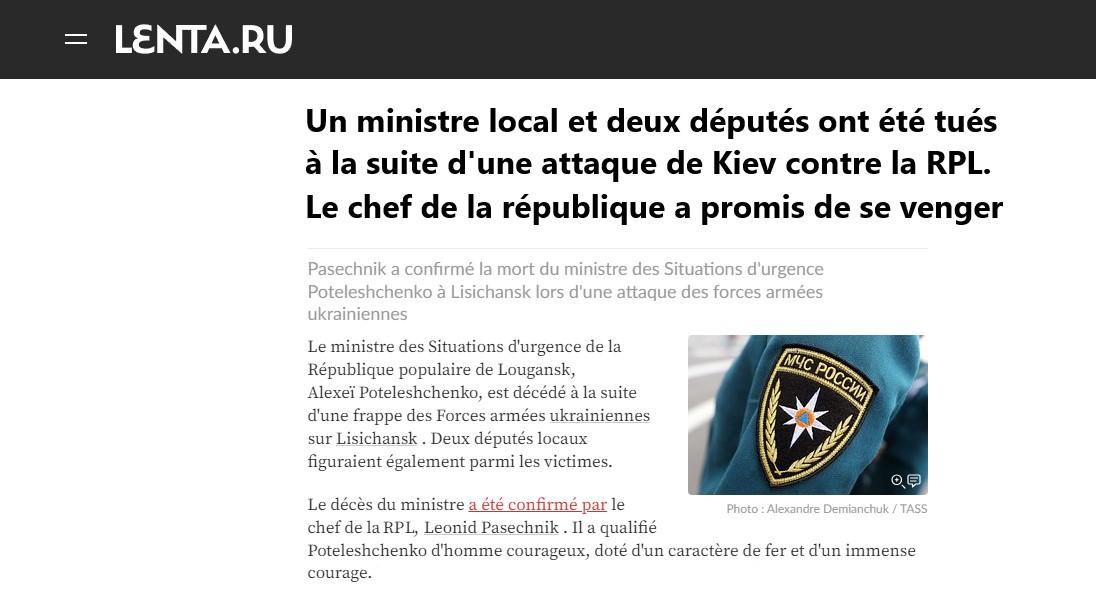
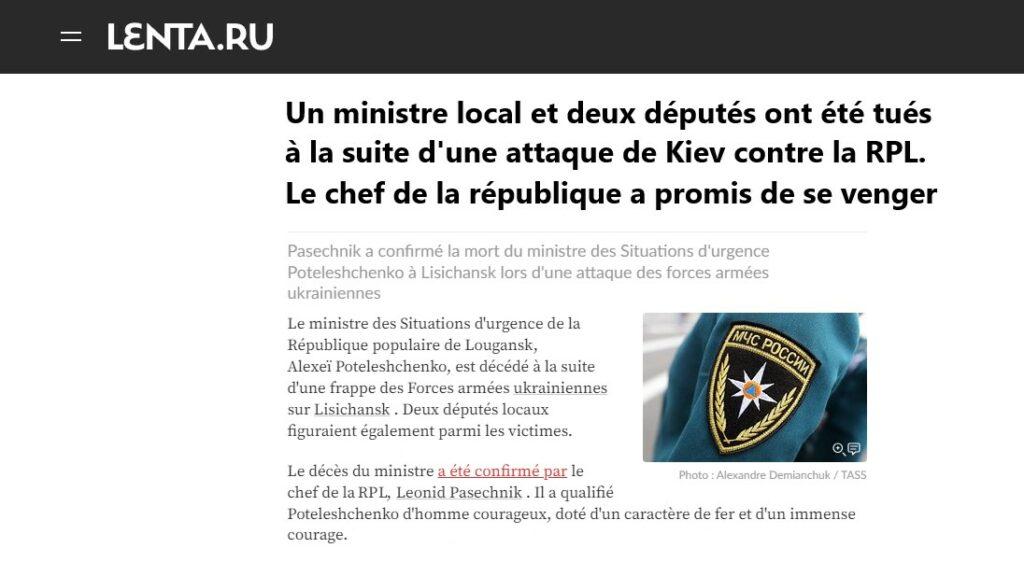 Le ministre des Situations d’urgence de la République populaire de Lougansk (RPL), Alexeï Poteleshchenko, est décédé à la suite d’une
Le ministre des Situations d’urgence de la République populaire de Lougansk (RPL), Alexeï Poteleshchenko, est décédé à la suite d’une
L’article Un ministre et des députés de la RPL tués dans un bombardement ukrainien est apparu en premier sur STRATPOL.
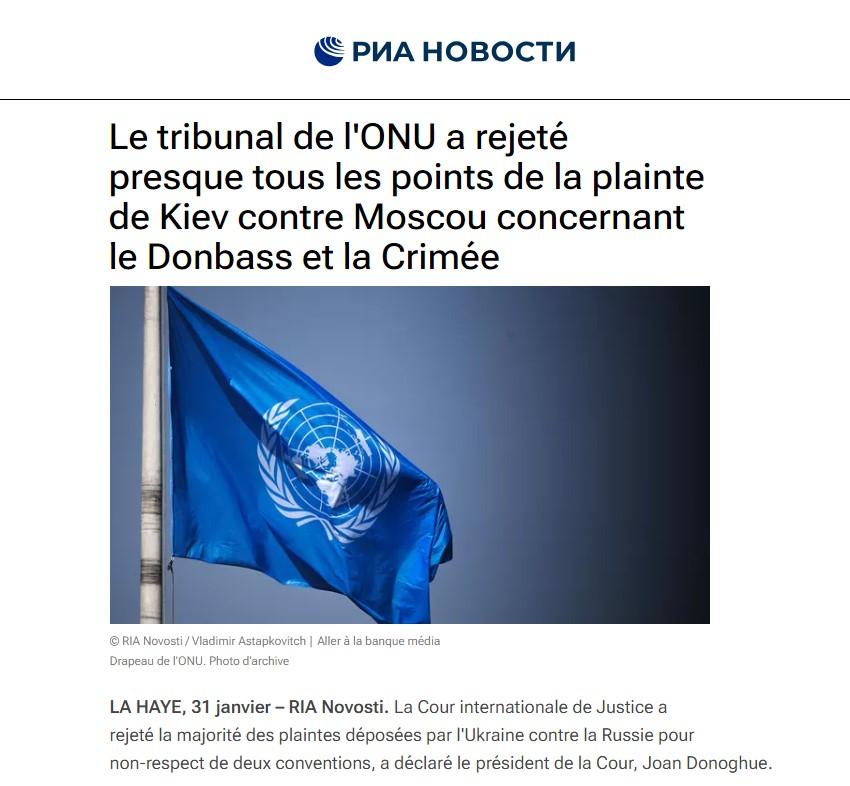
 La Cour internationale de Justice a rejeté la majorité des plaintes déposées par l’Ukraine contre la Russie pour non-respect de
La Cour internationale de Justice a rejeté la majorité des plaintes déposées par l’Ukraine contre la Russie pour non-respect de
L’article La Cour de Justice de l’ONU déboute la plupart des demandes de Kiev contre la Russie sur le Donbass et la Crimée est apparu en premier sur STRATPOL.
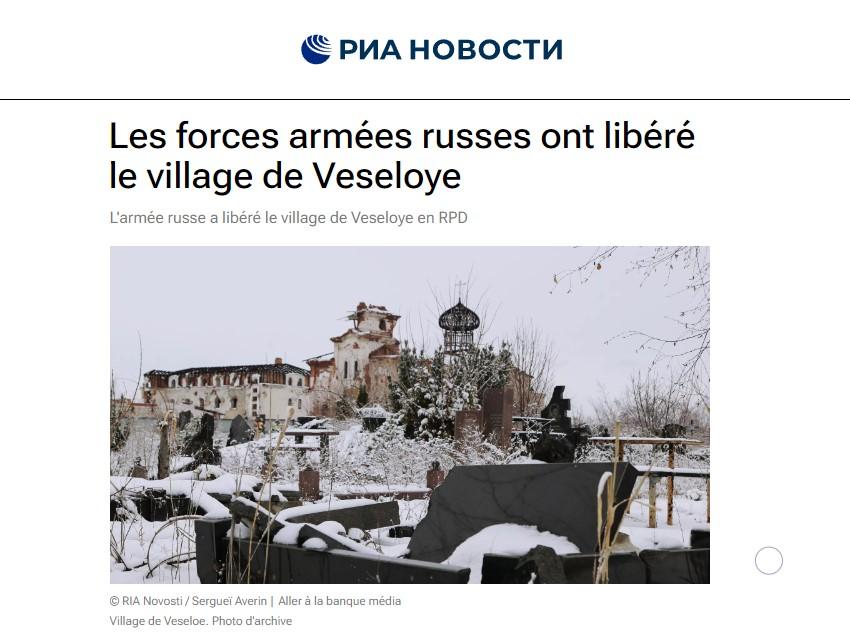
 Les troupes russes ont pris le contrôle du village de Veseloye en région de Donetsk, a rapporté le ministère de
Les troupes russes ont pris le contrôle du village de Veseloye en région de Donetsk, a rapporté le ministère de
L’article L’armée russe libère un village en RPD est apparu en premier sur STRATPOL.
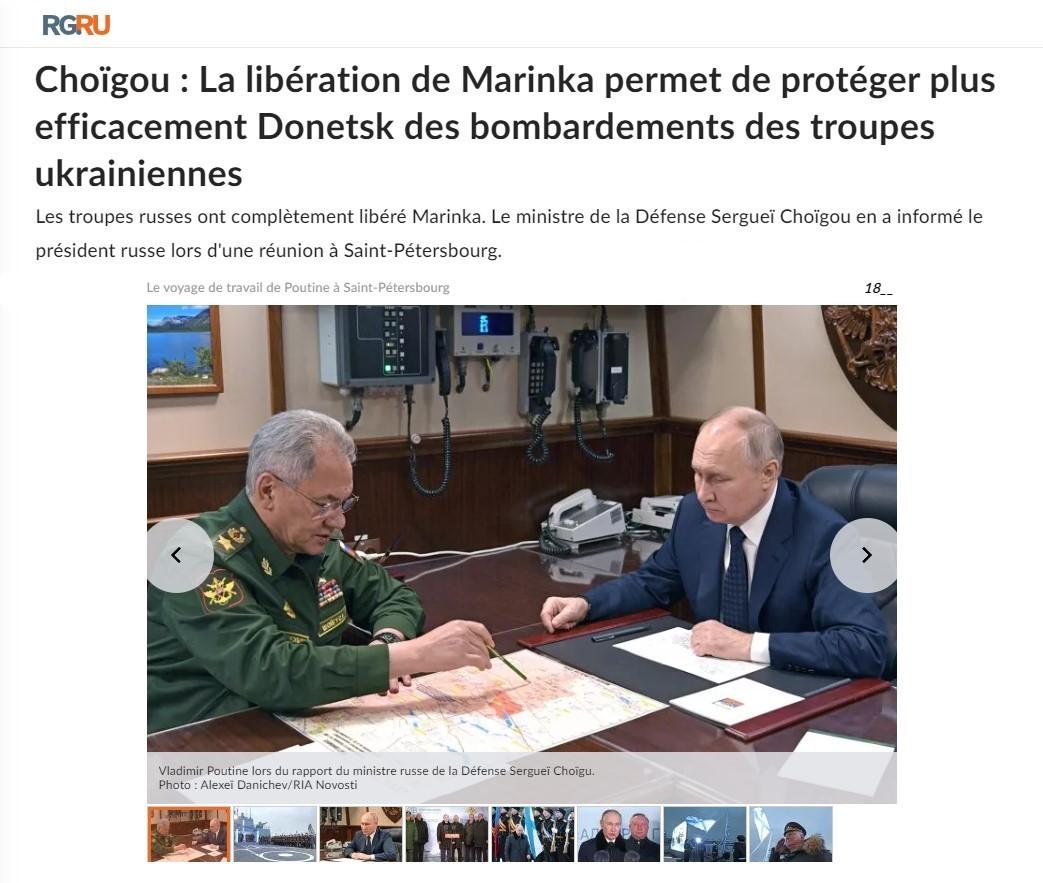
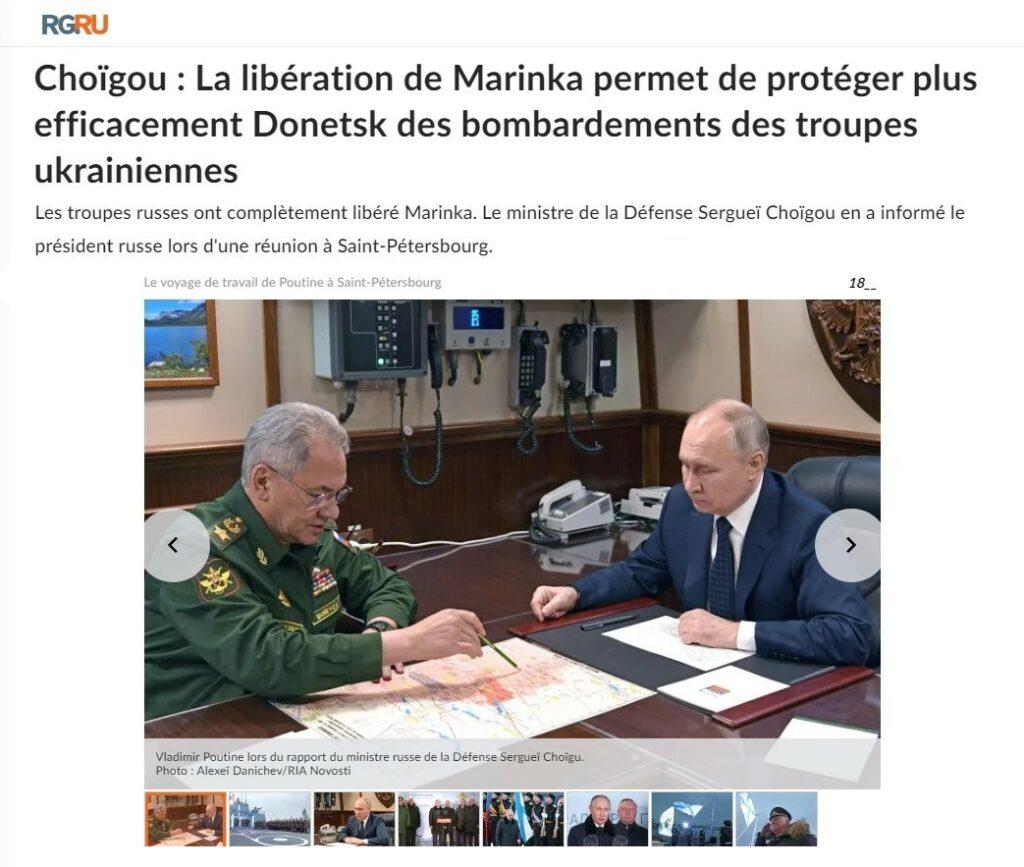 « Pendant neuf ans, les forces armées ukrainiennes y ont construit une puissante zone fortifiée, reliée par des passages souterrains,
« Pendant neuf ans, les forces armées ukrainiennes y ont construit une puissante zone fortifiée, reliée par des passages souterrains,
L’article La Russie a pris le contrôle de la ville de Marinka, en banlieue de Donetsk est apparu en premier sur STRATPOL.
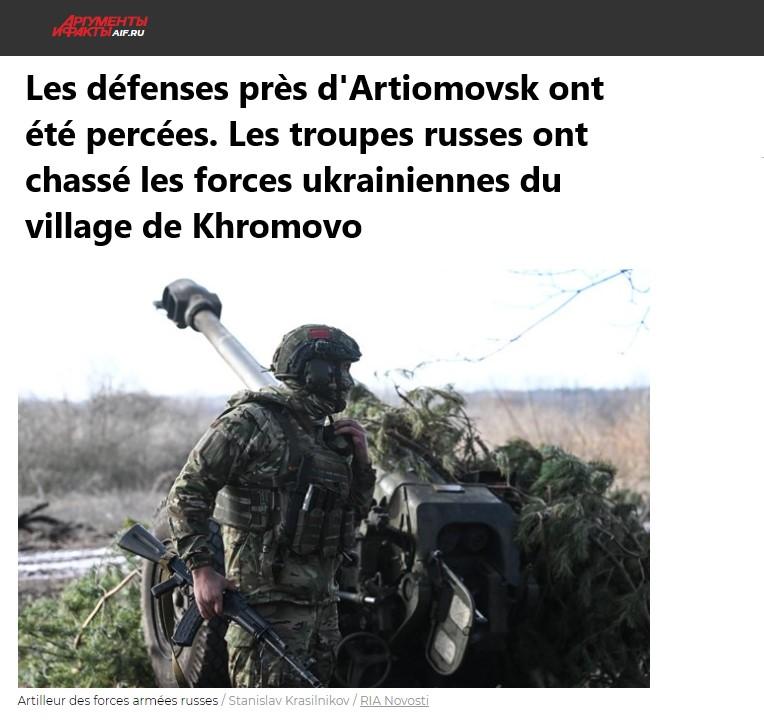
 Les troupes d’assaut russes sont entrées dans le village de Khromovo, situé à la périphérie ouest d’Artiomovsk. Les forces armées
Les troupes d’assaut russes sont entrées dans le village de Khromovo, situé à la périphérie ouest d’Artiomovsk. Les forces armées
L’article L’armée russe a pris le village de Khromovo à l’ouest d’Artiomovsk est apparu en premier sur STRATPOL.
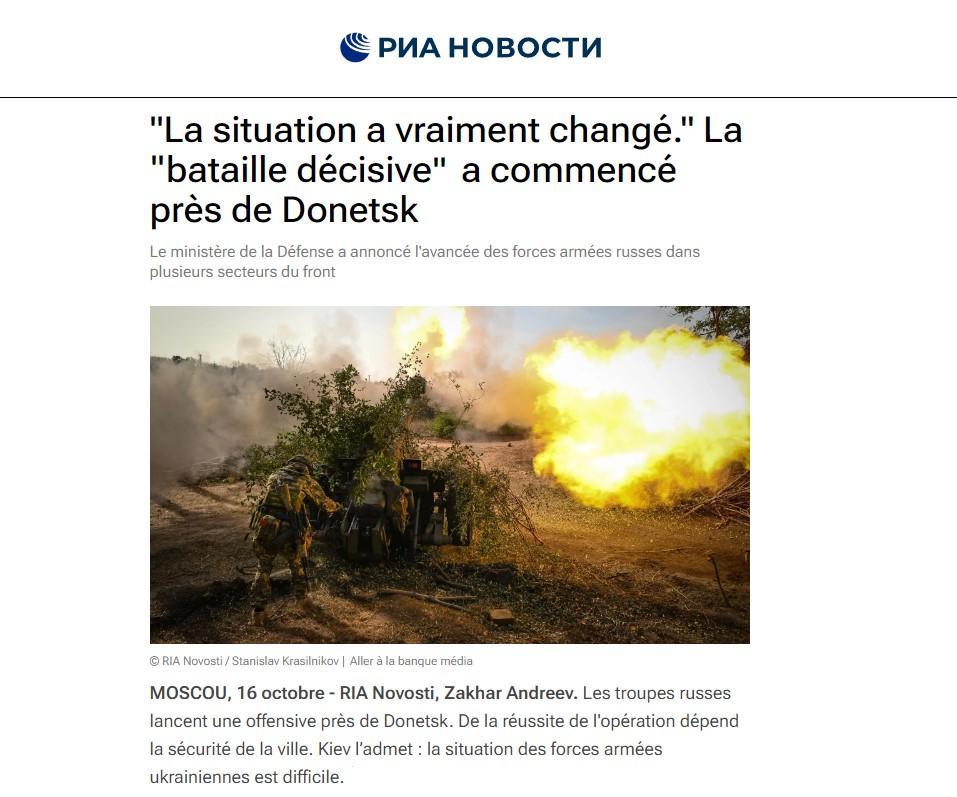
 Les troupes russes lancent une offensive près de Donetsk. De la réussite de l’opération dépend la sécurité de la ville.
Les troupes russes lancent une offensive près de Donetsk. De la réussite de l’opération dépend la sécurité de la ville.
L’article L’armée russe annonce des avancées significatives en Ukraine est apparu en premier sur STRATPOL.
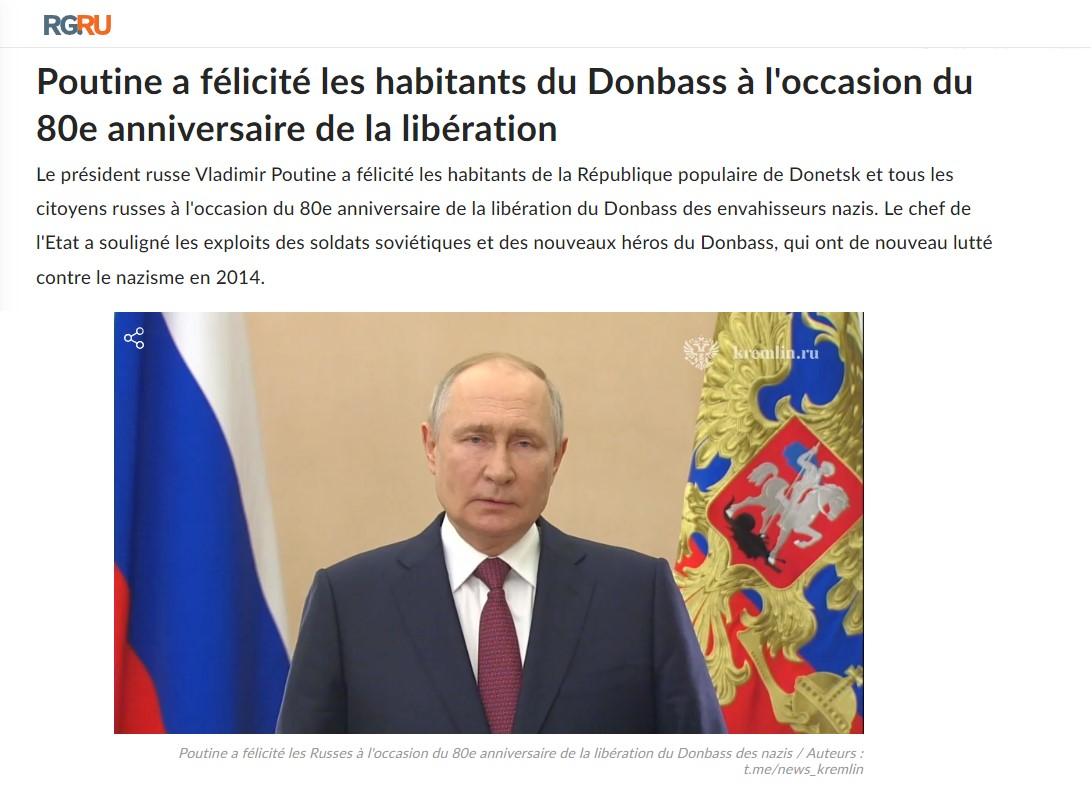
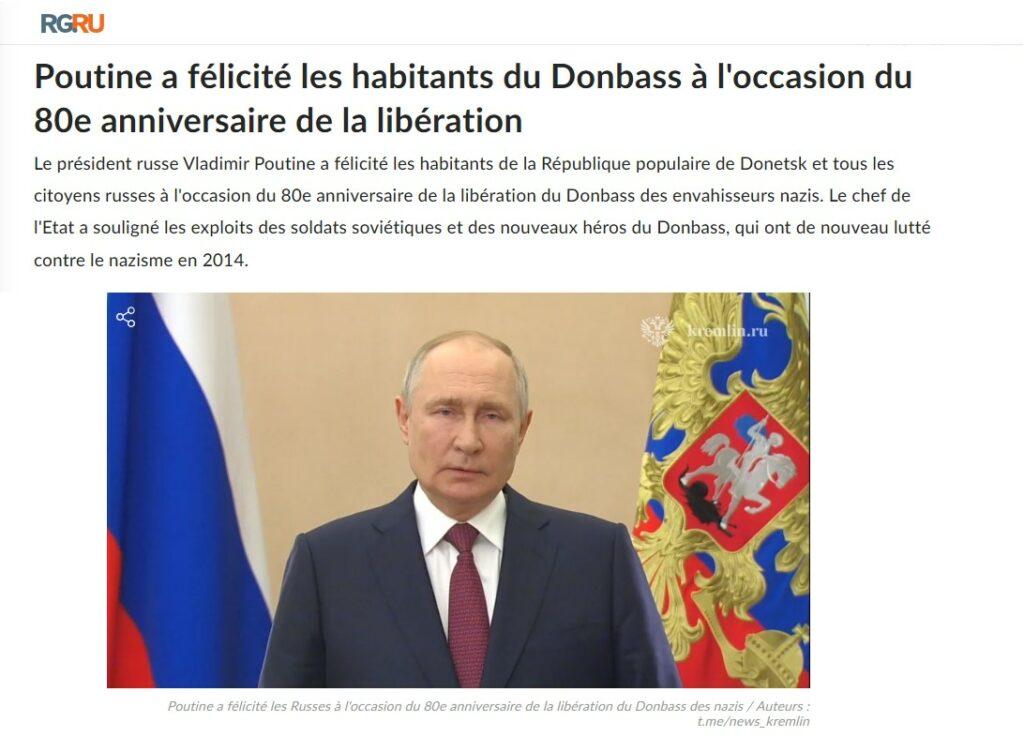 Le président russe Vladimir Poutine a félicité les habitants de la République populaire de Donetsk et tous les citoyens russes
Le président russe Vladimir Poutine a félicité les habitants de la République populaire de Donetsk et tous les citoyens russes
L’article Poutine adresse un message au Donbass à l’occasion des 80 ans de sa libération contre les nazis en 1943 est apparu en premier sur STRATPOL.
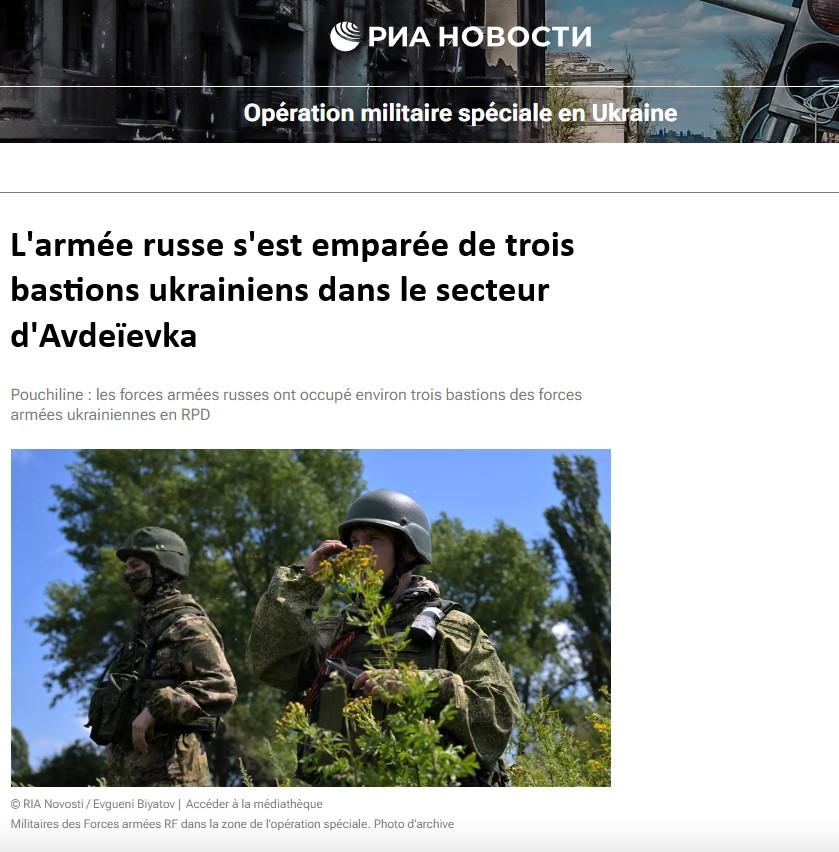
 L’armée russe a occupé environ trois bastions de l’ennemi dans le secteur d’Avdeïvka en RPD, a déclaré Denis Pouchiline, le
L’armée russe a occupé environ trois bastions de l’ennemi dans le secteur d’Avdeïvka en RPD, a déclaré Denis Pouchiline, le
L’article L’armée russe a pris trois bastions ukrainiens dans le secteur d’Avdeïevka est apparu en premier sur STRATPOL.
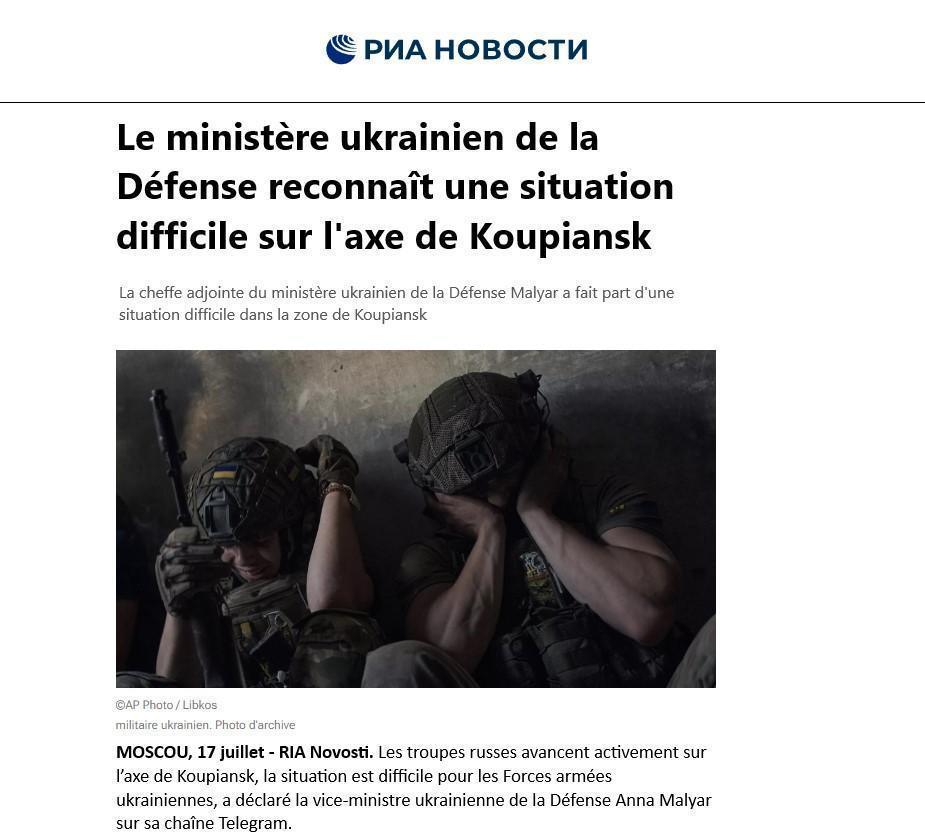
 Les troupes russes avancent activement sur l’axe de Koupiansk, la situation est difficile pour les Forces armées ukrainiennes, a déclaré
Les troupes russes avancent activement sur l’axe de Koupiansk, la situation est difficile pour les Forces armées ukrainiennes, a déclaré
L’article Kiev reconnaît une situation difficile sur l’axe de Koupiansk est apparu en premier sur STRATPOL.
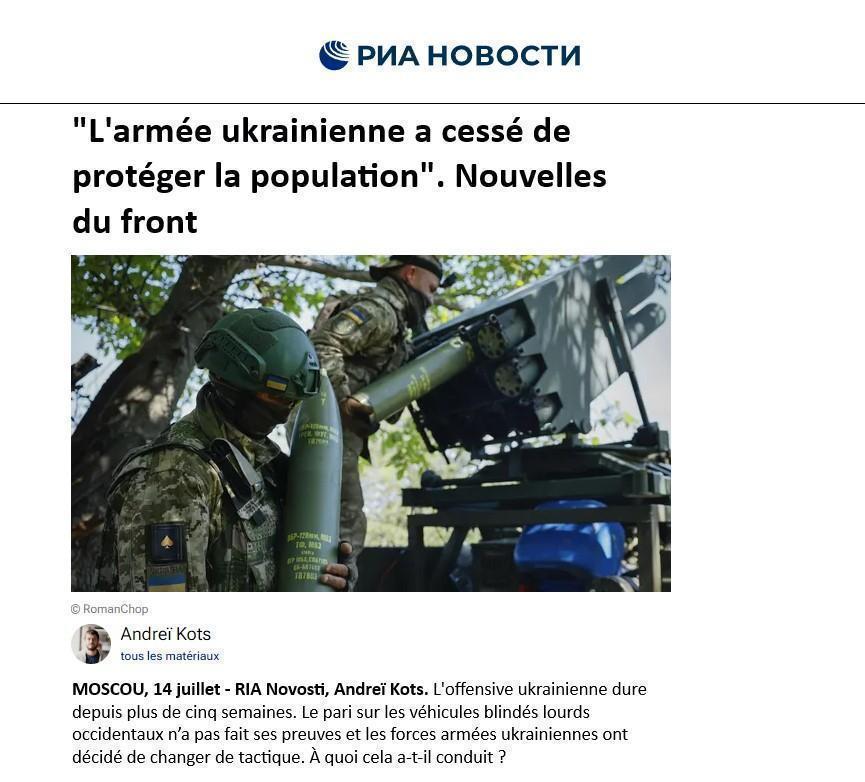
 L’offensive ukrainienne dure depuis plus de cinq semaines. Le pari sur les véhicules blindés lourds occidentaux n’a pas fait ses
L’offensive ukrainienne dure depuis plus de cinq semaines. Le pari sur les véhicules blindés lourds occidentaux n’a pas fait ses
L’article Après cinq semaines d’offensive ratée, la nouvelle tactique ukrainienne échoue aussi est apparu en premier sur STRATPOL.
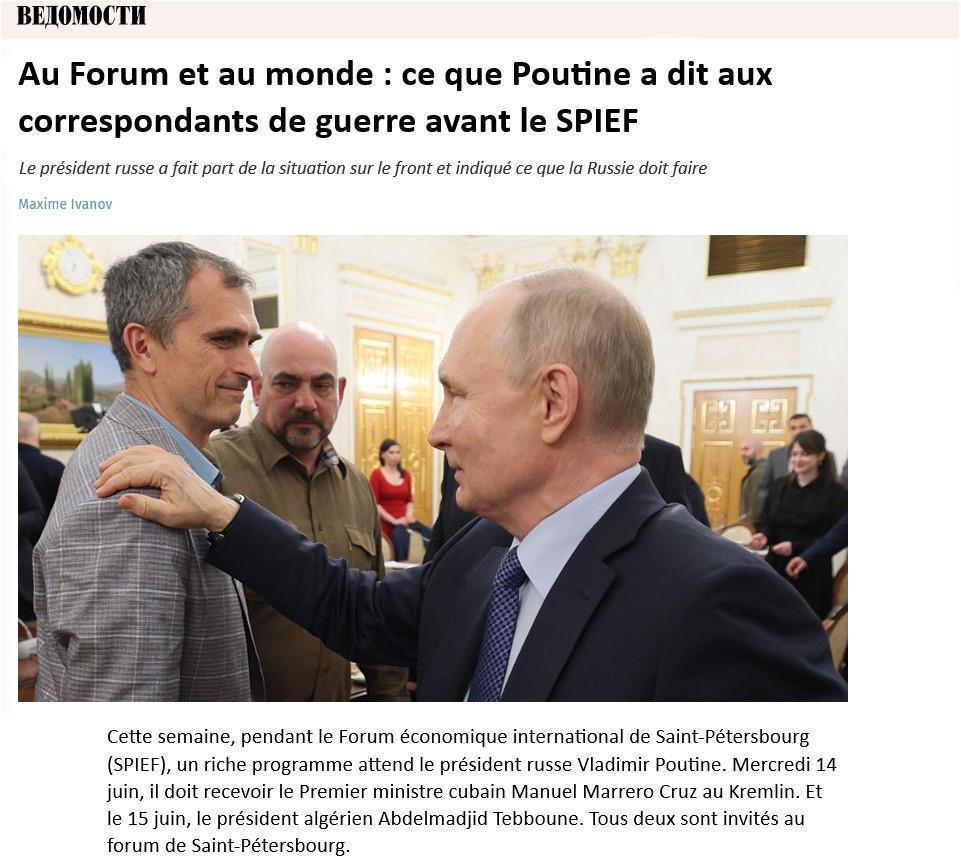
 Cette semaine, pendant le Forum économique international de Saint-Pétersbourg (SPIEF), un riche programme international attend le président russe Vladimir Poutine.
Cette semaine, pendant le Forum économique international de Saint-Pétersbourg (SPIEF), un riche programme international attend le président russe Vladimir Poutine.
L’article Poutine rencontre les correspondants de guerre en amont du SPIEF est apparu en premier sur STRATPOL.
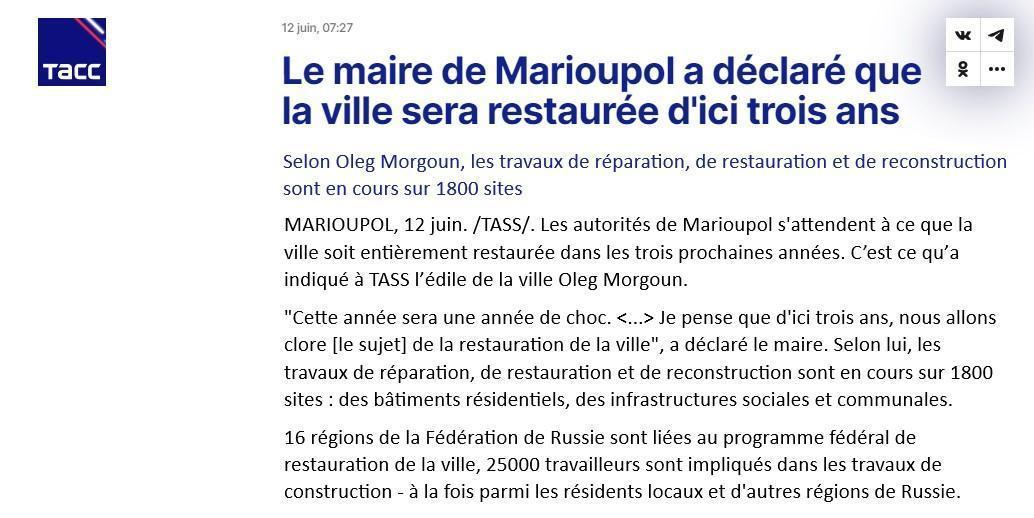
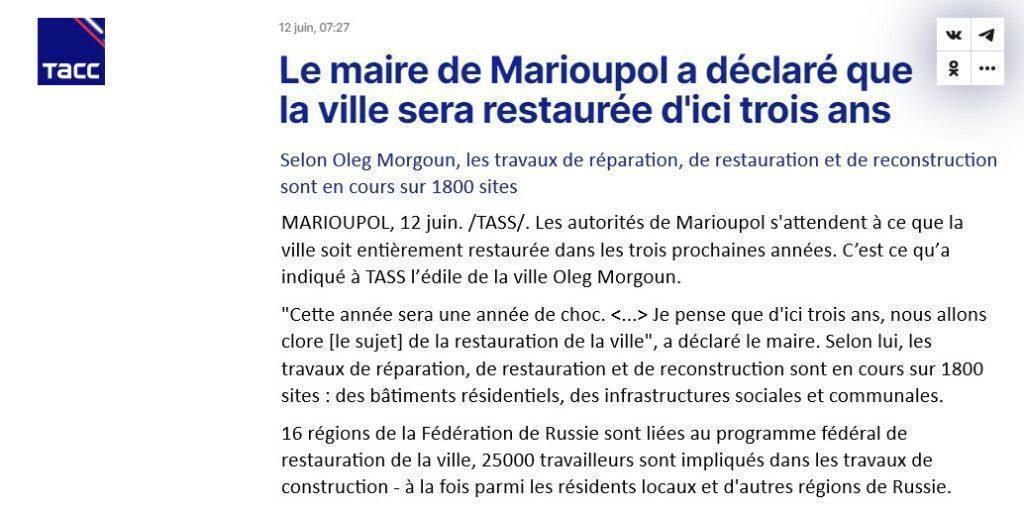 Les autorités de Marioupol s’attendent à ce que la ville soit entièrement restaurée dans les trois prochaines années. C’est ce
Les autorités de Marioupol s’attendent à ce que la ville soit entièrement restaurée dans les trois prochaines années. C’est ce
L’article Marioupol devrait être reconstruite en trois ans est apparu en premier sur STRATPOL.
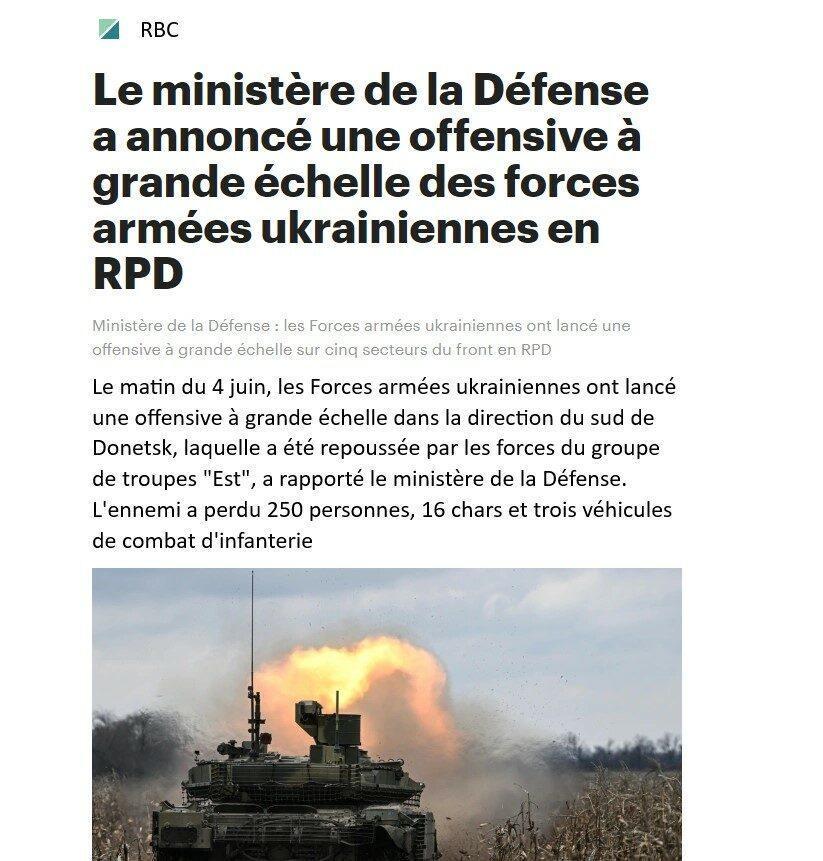
 Le matin du 4 juin, les Forces armées ukrainiennes ont lancé une offensive à grande échelle dans la direction du
Le matin du 4 juin, les Forces armées ukrainiennes ont lancé une offensive à grande échelle dans la direction du
L’article Une offensive à grande échelle de l’armée de Kiev repoussée dans le Donbass est apparu en premier sur STRATPOL.
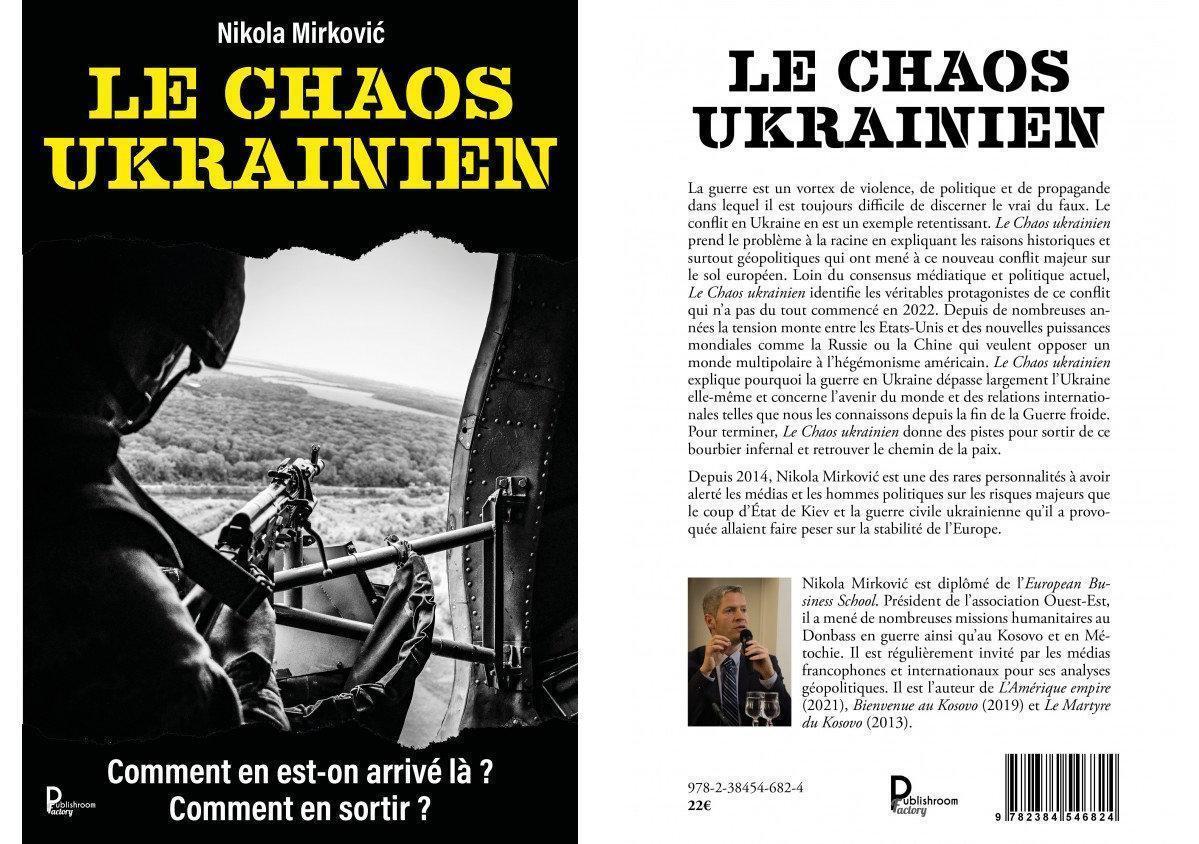
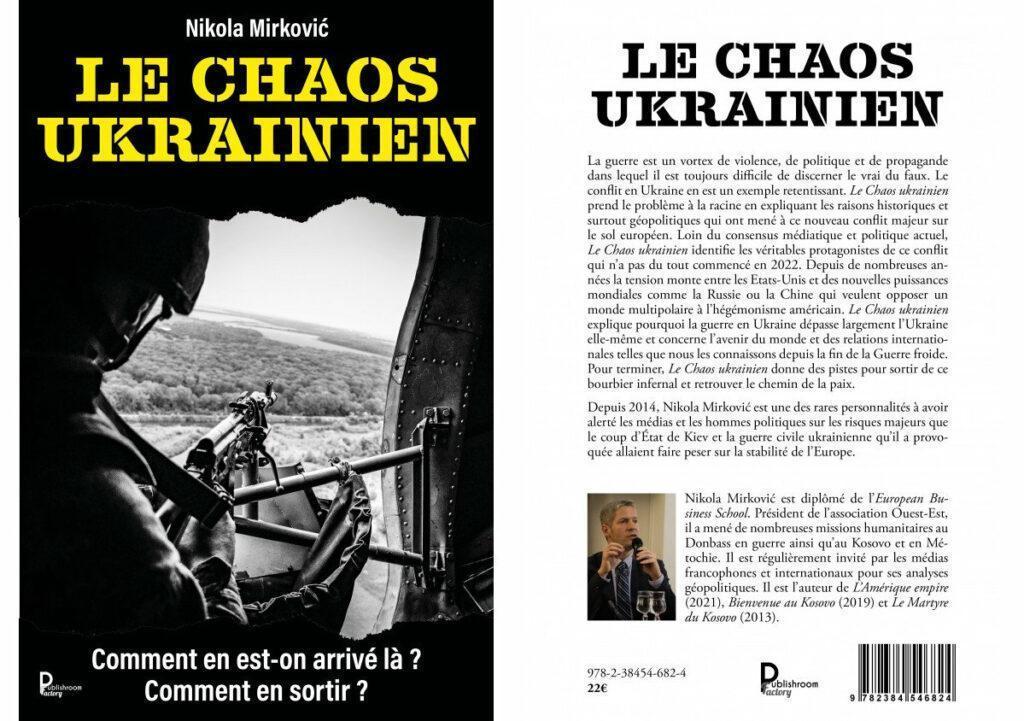 La guerre est un vortex de violence, de politique et de propagande dans lequel il est toujours difficile de discerner
La guerre est un vortex de violence, de politique et de propagande dans lequel il est toujours difficile de discerner
L’article Le chaos ukrainien est apparu en premier sur STRATPOL.
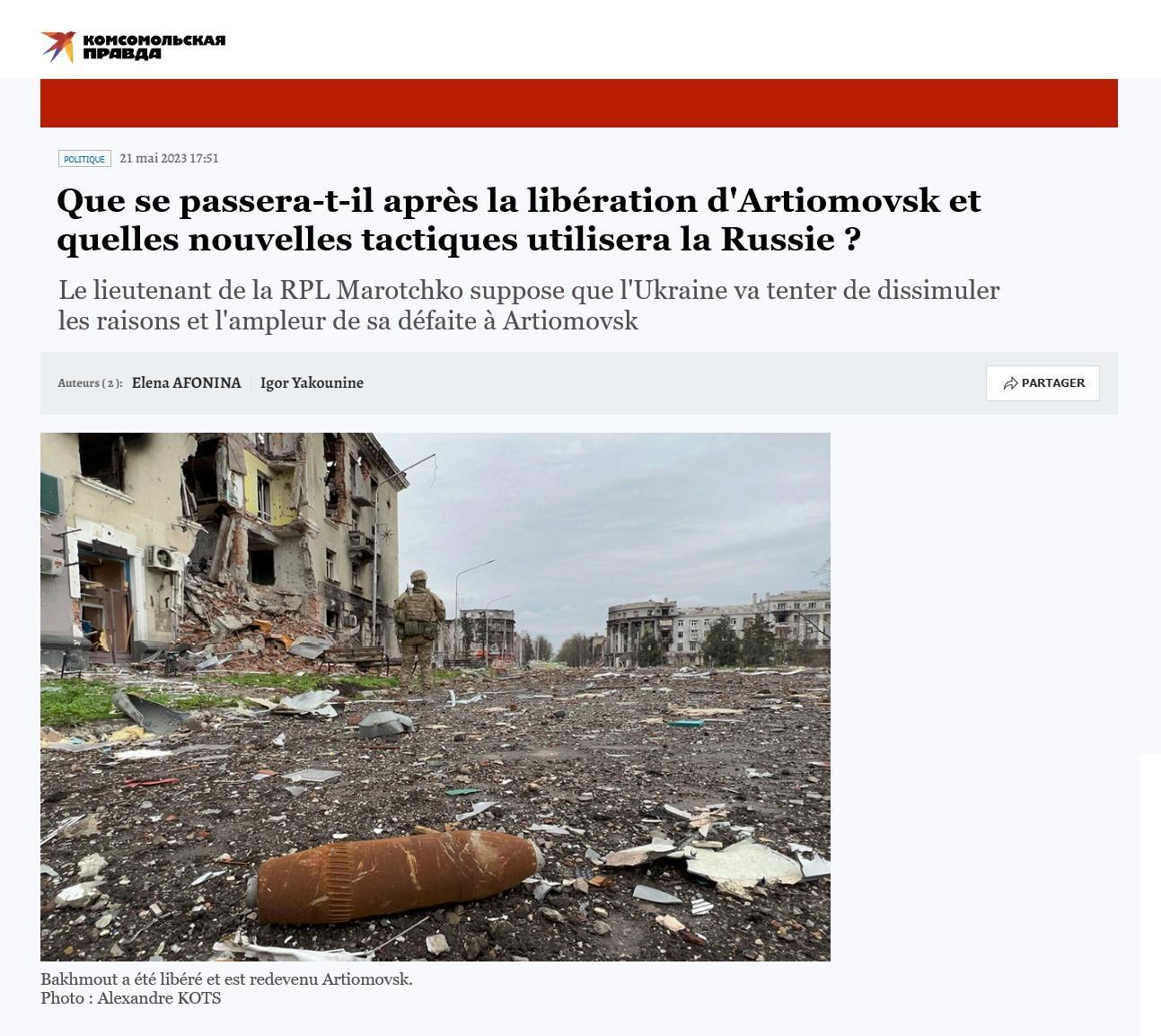
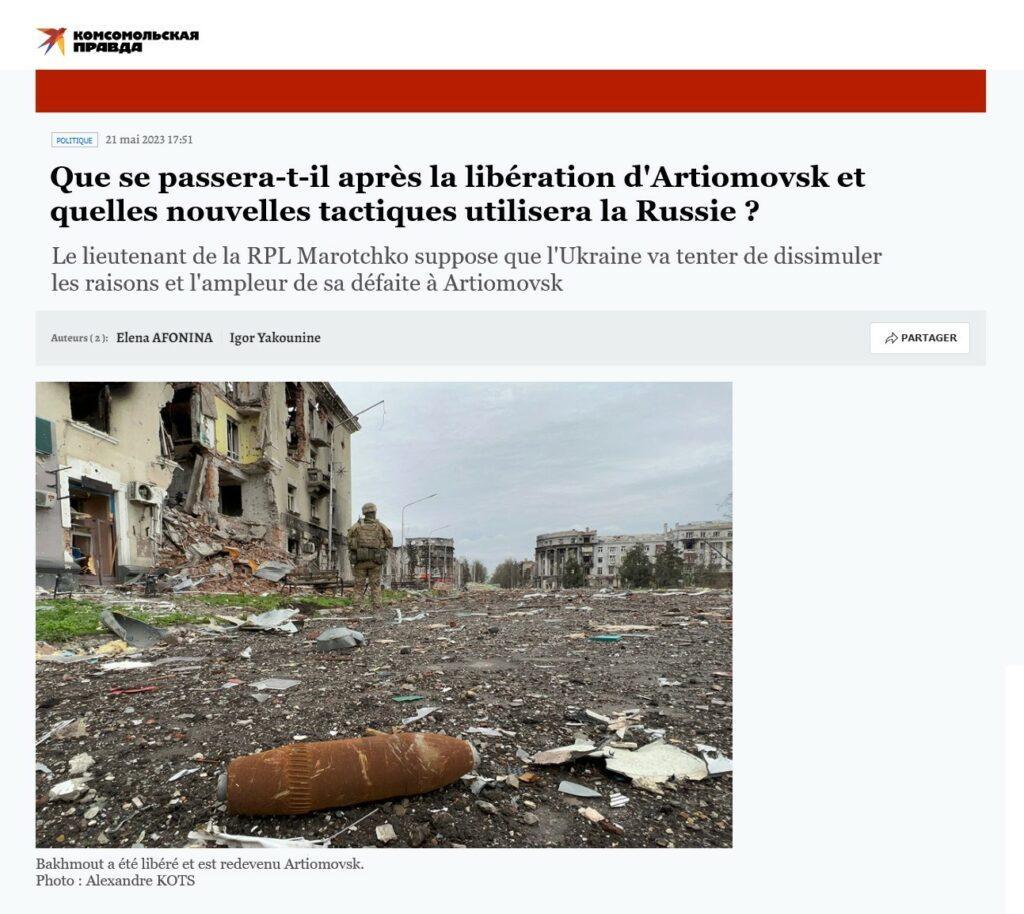 Bakhmout a été libéré et est redevenu Artiomovsk. Dans la nuit du 21 mai 2023, le ministère de la Défense
Bakhmout a été libéré et est redevenu Artiomovsk. Dans la nuit du 21 mai 2023, le ministère de la Défense
L’article Artiomovsk libéré, quelle sera la prochaine étape ? est apparu en premier sur STRATPOL.
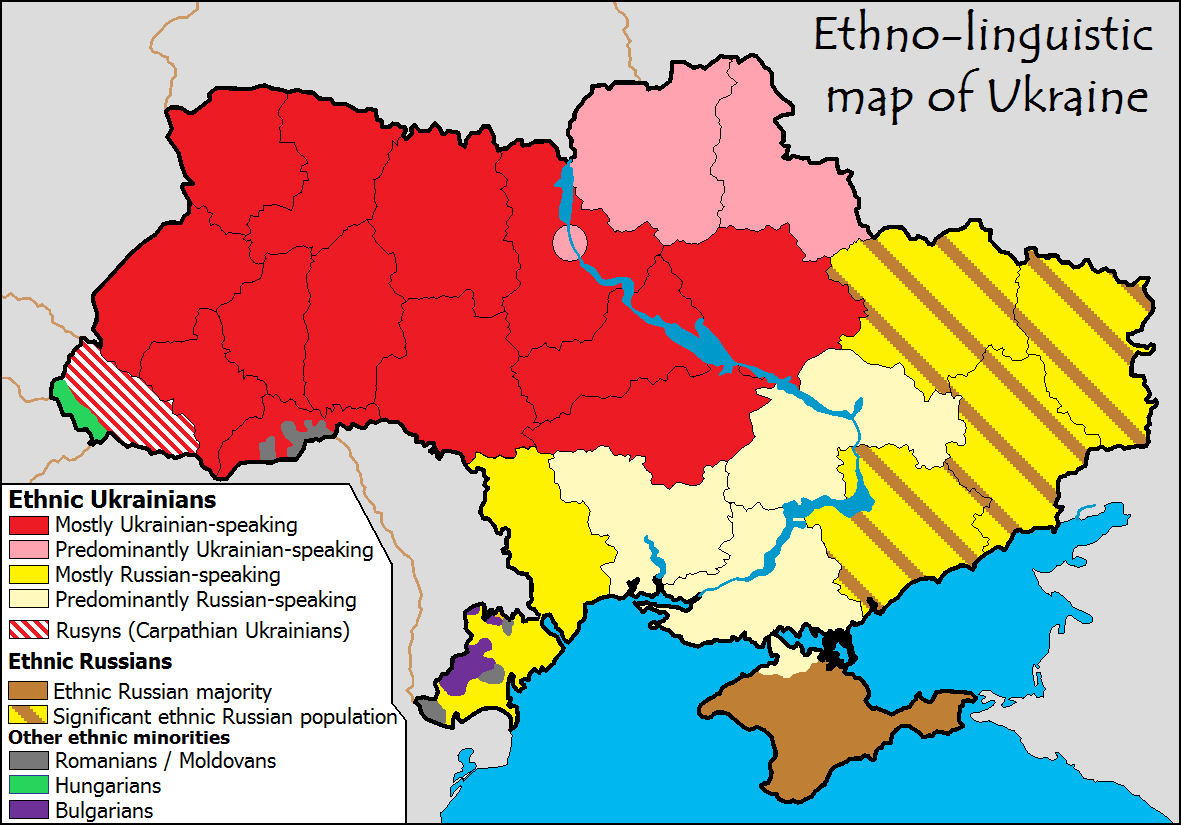
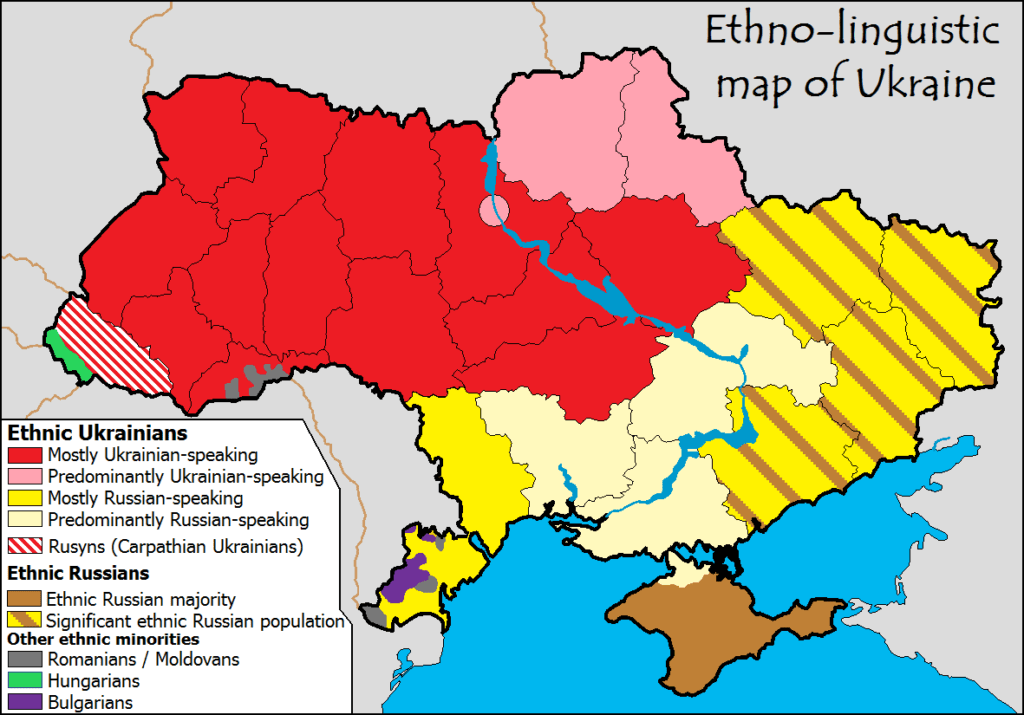 L’intervention militaire russe en Ukraine du 24 février a provoqué un émoi international. Récemment arrivé en Russie, j’ai souhaité comprendre
L’intervention militaire russe en Ukraine du 24 février a provoqué un émoi international. Récemment arrivé en Russie, j’ai souhaité comprendre
L’article Comprendre la crise ukrainienne en germe depuis huit ans est apparu en premier sur STRATPOL.
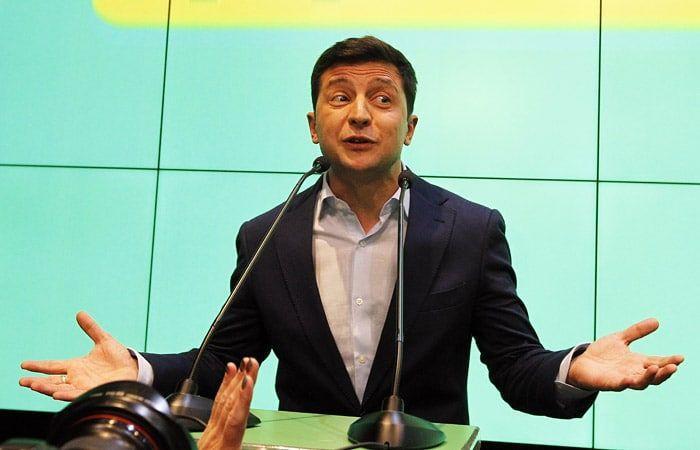
 Le mois d’avril 2021 a marqué le deuxième anniversaire de l’élection de Vladimir Zelenski à la présidence de l’Ukraine. Comme
Le mois d’avril 2021 a marqué le deuxième anniversaire de l’élection de Vladimir Zelenski à la présidence de l’Ukraine. Comme
L’article Vladimir Zelenski, autopsie d’un désastre. est apparu en premier sur STRATPOL.
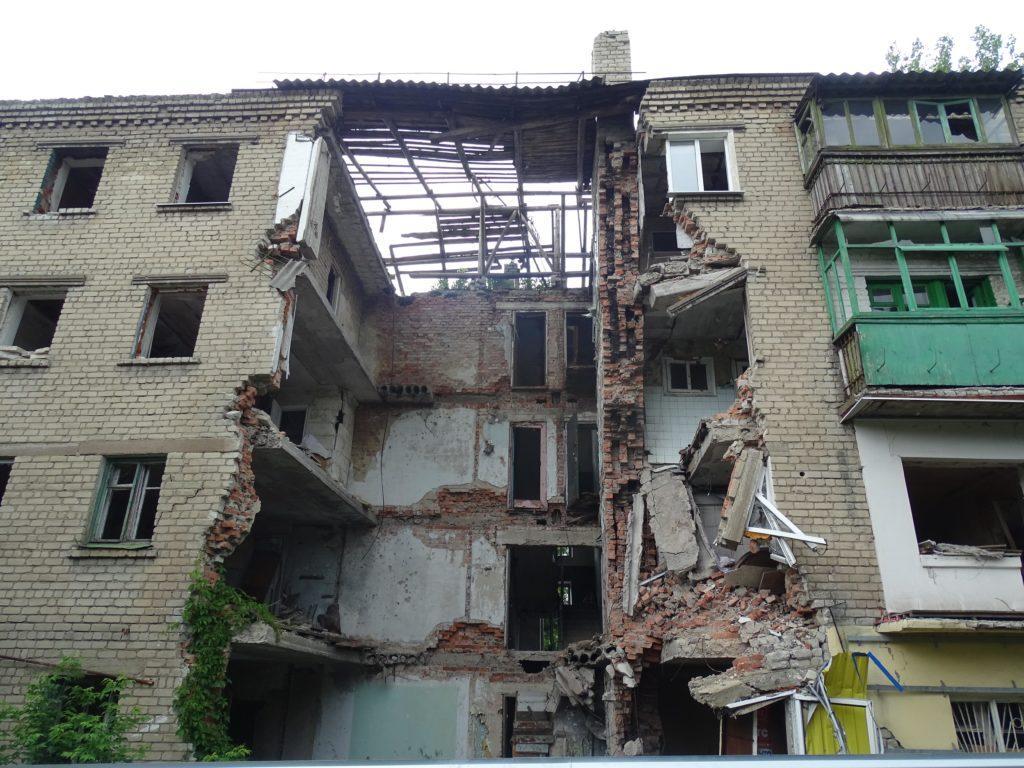 « Nous sommes du Donbass, nous sommes des mineurs, des ouvriers mais nous nous sommes soulevés et nous nous sommes
« Nous sommes du Donbass, nous sommes des mineurs, des ouvriers mais nous nous sommes soulevés et nous nous sommes
L’article Entretien avec deux vétérans des forces insurgées du Donbass. est apparu en premier sur STRATPOL.
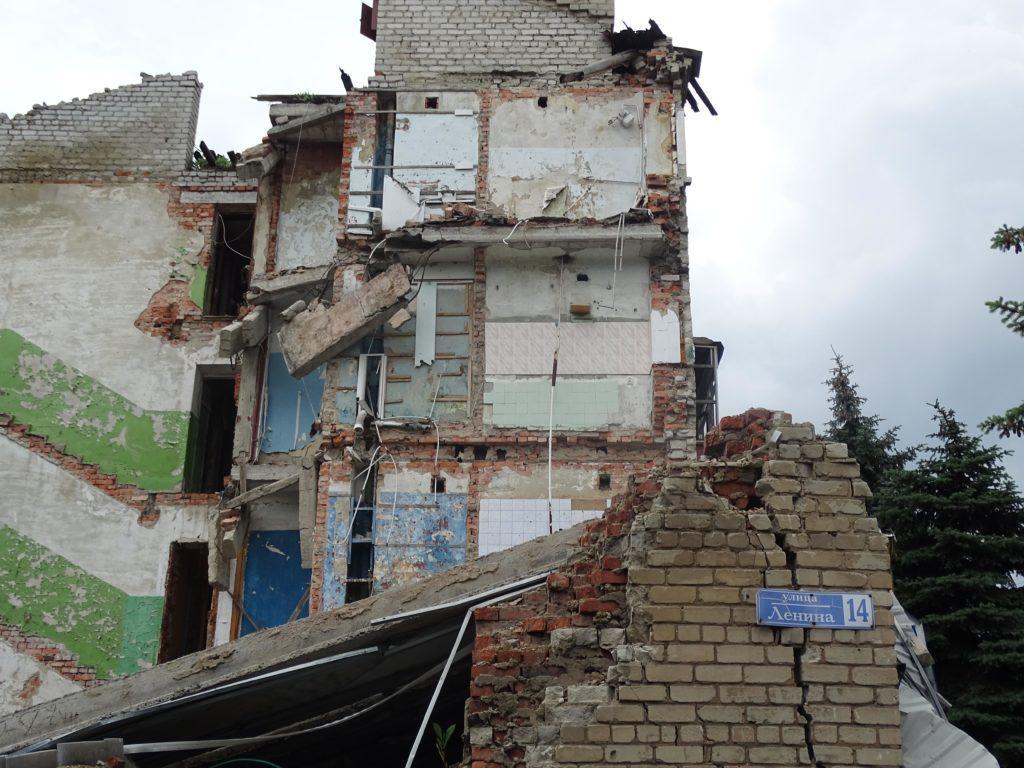 Comme d’autres villes et villages du Donbass Snejnoe (Snijne en ukrainien) a payé un lourd tribut au conflit qui ravage
Comme d’autres villes et villages du Donbass Snejnoe (Snijne en ukrainien) a payé un lourd tribut au conflit qui ravage
L’article Snejnoe, ville héroïque est apparu en premier sur STRATPOL.